 27/07/2009 12:42 27/07/2009 12:42 |
|
| | | OFFLINE | | Post: 18.030
Post: 693 | Registrato il: 28/08/2005
Registrato il: 20/01/2009 | Administratore | Utente Senior | |
|

 In the preceding page, I posted a great number of photos captured from the full video of the Vespers in Aosta last Friday on aspects of the event not reflected in the newsphotos that were made available.
In the preceding page, I posted a great number of photos captured from the full video of the Vespers in Aosta last Friday on aspects of the event not reflected in the newsphotos that were made available.

July 27
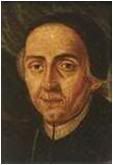 Blessed Antonio Lucci (Italy, 1682-1752)
Blessed Antonio Lucci (Italy, 1682-1752)
Franciscan and Bishop
No OR today.
THE POPE ON VACATION - DAY 15
And the days dwindle down...
The Holy Father goes to Castel Gandolfo
for the rest of the summer on Wednesday, July 29.
[Modificato da TERESA BENEDETTA 27/07/2009 13:13] |
| |
|
| |
 27/07/2009 13:25 27/07/2009 13:25 |
|
| | | OFFLINE | | Post: 18.031
Post: 694 | Registrato il: 28/08/2005
Registrato il: 20/01/2009 | Administratore | Utente Senior | |
|
 Pope Benedict XVI
Pope Benedict XVI
unfrocks Medjugorje priest
Father Tomislav Vlasic, the priest who helped to turn the Bosnian town of Medjugorje
into one of the Catholic Church's most visited shrines, has left the priesthood
after being placed under investigation by the Vatican.
By Simon Caldwell

Published: 8:00AM BST 27 Jul 2009
Father Tomislav Vlasic, the former "spiritual director" to six visionaries who claim that the Virgin Mary visited them nearly 40,000 times over 28 years, has been laicised by Pope Benedict XVI a year after he was placed under investigation over allegations that he exaggerated the apparitions and had engaged in sexual relations with a nun.
While the Vatican has never given the shrine its formal blessing, an estimated 30 million pilgrims have visited Medjugorje in the last three decades and hundreds of thousands make the journey from Britain and Ireland each year.
The unfrocking of Father Vlasic will come as a blow to Medjugorje followers worldwide who were hoping that the Vatican would one day legitimise the controversial shrine.
The Franciscan was asked to leave the priesthood after the Vatican launched an investigation into allegations that he was guilty of sexual immorality with a nun which he then covered up.
He was also suspected of exagerating stories of the Virgin Mary's appearance and under formal investigation for alleged "dubious doctrine, the manipulation of consciences, suspect mysticism and disobedience towards legitimately issued orders".
Father Vlasic refused to co-operate with the investigation from the outset and he was banished to a monastery in L'Aquila, Italy, where he was forbidden to communicate with anyone, even his lawyers, without the permission of his superior.
He has not commented on the allegations but told the Vatican that he felt wronged given he had turned Medjugorje into an international shrine and generated funds to build new churches.
It emerged on Sunday that he has chosen to leave the priesthood and his order, a move which has brought the investigation to an abrupt halt.
But the Pope has insisted that Father Vlasic observes a set of conditions on pain of excommunication which include a total ban on teaching Christian doctrine and giving spiritual direction.
There is also an "absolute prohibition of releasing declarations on religious matters, especially regarding the phenomenon of Medjugorje".
It seems to me that the Medjugorje mass pilgrimage phenomenon is a sign of the times: how willing - maybe even desperate - modern Catholics are to reinforce their faith through belief in the 'supernatural', Marian apparitions in this case, no matter if the Church has not 'validated' them.
Frankly, it strains credulity to believe the claim by one or more of the Medjugorje 'seers' that the Virgin Mary has appeared daily to him/her for the past 28 years - and yet it is typical of the claims put forward and promoted by Fr. Vlasic and his 'spiritual wards'. Subsequent reports of how Vlasic and the seers themselves appear to have profited materially from their 'fame' simply add to the disquieting aspects of this cultural phenomenon.
The Church has taken the sensible position that no Roman Catholic priest should lead pilgrimages to Medjugorje because that would give the mistaken impression that the Church has put its imprimatur on the 'apparitions' there as it did for Lourdes and Fatima.
At the same time, the Church points out that one should not minimize the faith that draws pilgrims to Medjugorje provided their prayers are not simply in the hope of getting a miracle. Faith should not require supernatural proof, because by definition, it is 'the conviction about things not seen'.
[Modificato da TERESA BENEDETTA 28/07/2009 02:25] |
| |
 27/07/2009 14:28 27/07/2009 14:28 |
|
| | | OFFLINE | | Post: 18.032
Post: 695 | Registrato il: 28/08/2005
Registrato il: 20/01/2009 | Administratore | Utente Senior | |
|
 Day 15 in Les Combes:
Day 15 in Les Combes:
'Normal' last 2 days
of vacation for the Pope
Adapted and translated from

LES COMBES - "We expect today and tomorrow to be quiet, without any particular commitments," Fr. Federico Lombardi said today as the Pope's vacation winds down, ending Wednesday. "The Pope will dedicate himself as usual to prayer, study and reading."
Before he leaves Les Combes on Wednesday, he will meet in the morning with the local and state security forces, firemen and others who were assigned to insure his security during his holiday in Val D'Aosta.
"In the afternoon, a meeting with local authorities before leaving by helicopter around 5 p.m. for the airport at Torino-Caselle, from where he will fly back to Rome-Ciampino airport. He will proceed from the airport directly to Castel Gandolfo where he is expected in time for dinner".
Additionally, Fr. Lombardi also confirmed that Benedict XVI will be visiting Turin next spring when the Holy Shroud goes on public exposition on April 10-May 23, 2010.
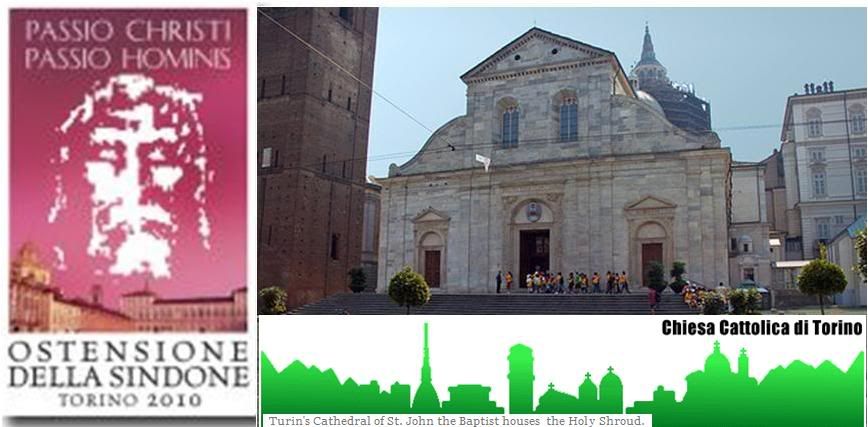
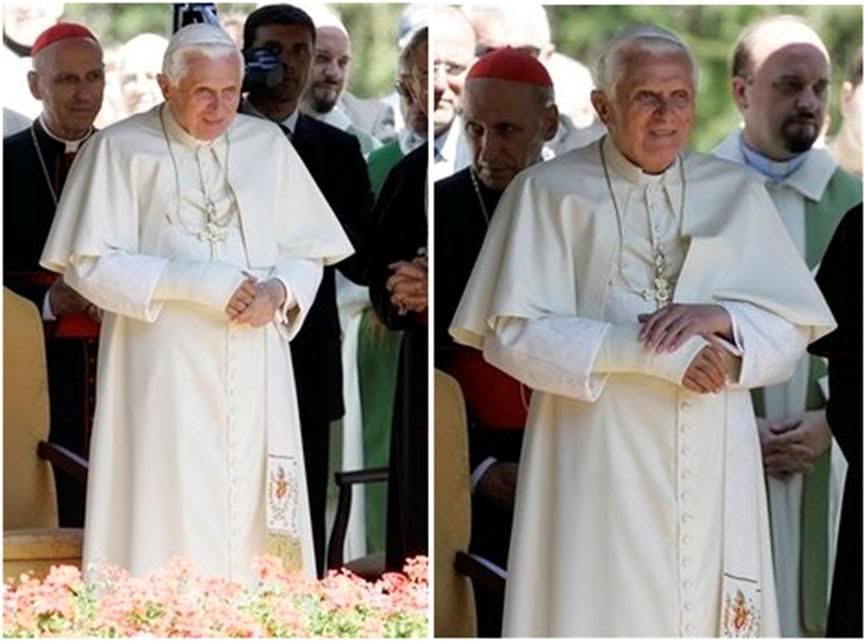 Cardinal Poletto behind the Holy Father at the Angelus yesterday
Cardinal Poletto behind the Holy Father at the Angelus yesterday.
Lombardi said the Pope received an update on preparations for the exposition - which he authorized last year - from Cardinal Severino Poletto, Archbishop of Turin, who had lunch with the Pope yesterday after the Angelus. Also present was the Bishop of Aosta, Mons. Giuseppe Anfossi.
he Vatican press director said "The Pope ended the day yesterday with his usual evening walk, thus concluding a Sunday marked by a festive encounter with the faithful for the Angelus, and lunch with some guests, among them, Cardinal Poletto and Bishop Anfossi."
Background information on the Shroud
from Cindy Wooden

The last time the Shroud of Turin was displayed to the public was in 2000 for the jubilee year. The shroud is removed from a specially designed protective case only for very special spiritual occasions, and its removal for study or display to the public must be approved by the pope.
The shroud underwent major cleaning and restoration in 2002.
According to tradition, the 14-foot-by-4-foot linen cloth is the burial shroud of Jesus. The shroud has a full-length photonegative image of a man, front and back, bearing signs of wounds that correspond to the Gospel accounts of the torture Jesus endured in his passion and death.
The Church has never officially ruled on the shroud's authenticity, saying judgments about its age and origin belonged to scientific investigation. Scientists have debated its authenticity for decades, and studies have led to conflicting results.
A recent study by French scientist Thierry Castex has revealed that on the shroud are traces of words in Aramaic spelled with Hebrew letters.
A Vatican researcher, Barbara Frale, told Vatican Radio July 26 that her own studies suggest the letters on the shroud were written more than 1,800 years ago.
She said that in 1978 a Latin professor in Milan noticed Aramaic writing on the shroud and in 1989 scholars discovered Hebrew characters that probably were portions of the phrase "The king of the Jews."
Castex's recent discovery of the word "found" with another word next to it, which still has to be deciphered, "together may mean 'because found' or 'we found,'" she said.
What is interesting, she said, is that it recalls a passage in the Gospel of St. Luke, "We found this man misleading our people," which was what several Jewish leaders told Pontius Pilate when they asked him to condemn Jesus.
She said it would not be unusual for something to be written on a burial cloth in order to indicate the identity of the deceased.
Frale, who is a researcher at the Vatican Secret Archives, has written a new book on the shroud and the Knights Templar, the medieval crusading order which, she says, may have held secret custody of the Shroud of Turin during the 13th and 14th centuries.
She told Vatican Radio that she has studied the writings on the shroud in an effort to find out if the Knights had written them.
"When I analyzed these writings, I saw that they had nothing to do with the Templars because they were written at least 1,000 years before the Order of the Temple was founded" in the 12th century, she said.
Andrea Tornielli of Il Giornale had the good sense to ask someone in the Pope's household last week how exactly the Pope broke his wrist - the only one to do so at the time. Now, Fr. Lombardi describes it himself in an interview with SKY-TV, as reported by both ANSA and Apcom.
Fr. Lombardi explains:
Pope stumbled against the bed
while trying to get to light switch

LES COMBES (AOSTA), July 27 (Translated from ANSA) - In the middle of the night between Thursday and Friday last week, Pope Benedict got up from bed and tried to get to a light switch but stumbled on the foot of the bed.
That is how he fell on his right wrist and fractured it, according to Fr. Federico Lombardi, speaking to Sky TG-24.
"The Pope got up in a dark room, which is also very different from his bedroom in the Vatican," Lombardi says. "He moved about to get to the light awitch, stumbled across the foot of the bed, fell down and hurt himself."
Lombardi confirms that the Pope did not wake anyone up, "he did not call for help, and he did not do anything about the injury."
But in the morning, he adds, "he noticed the wrist was swollen and painful," despite which he went ahead, said Mass and had breakfast.
Afterwards, however, the doctor was called [Dr. Polisca, who is staying at one of the houses in the nearby Salesian colony] and he decided the Pope should be go to the hospital. The rest of the story is known to all."
Among the videos on Russi's site is a roundup of videoclips taken when the Holy Father left the hospital in Aosta on Friday the 17th. Towards the very end, one newscast showed a very brief clip of the Pope arriving in Les Combes (the car is driving up to the main entrance at the side of the house, below right):
 and caught the two Memores housekeepers greeting him:
and caught the two Memores housekeepers greeting him:

[Modificato da TERESA BENEDETTA 28/07/2009 01:54] |
| |
 27/07/2009 16:14 27/07/2009 16:14 |
|
| | | OFFLINE | | Post: 18.034
Post: 696 | Registrato il: 28/08/2005
Registrato il: 20/01/2009 | Administratore | Utente Senior | |
|

 In a cathedral 16 centuries old,
In a cathedral 16 centuries old,
Benedict XVI restores the message
to make God known to man
Editorial
by ANGELO SCELZO
Translated from

July 26, 2009
In the increasingly eventful chapter of 'surprises' in Benedict VXI's Pontificate, the Vespers he celebrated at the Cathedral of Aosta last Friday is a new entry from many aspects.
Think of it: the Pope is on vacation, the rhythms of normal life are generally slowed down everywhere in summer, and a carefree atmosphere attests to the fact that summer is a season of the ephemeral.
And suddenly from the cathedral that was once St. Anselm's seat in Aosta, words come forth that resonate with the 16 centuries of faith conserved within those walls - recently restored to some of its ancient splendor - but also indicating the path for a new future, as Pope Benedict extemporized an extraordinary lesson of his Magisterium.
As father of the Church and its teacher in faith, the Pope can certainly not be limited in what he needs to say about the faith, even in the summer, nor for that matter, to keep a 'light touch', especially with the physical disability to his right wrist.
Indeed, we all got far more than we expected.
First of all, the beauty of language - a gift which helps and almost carries forward a course that the Pope himself says may appear more suggestive than demanding.
Or rather, suggestive because it is demanding: To affirm, in the silence of that cathedral, that "power means to be with those who suffer" and that "without God, the world has no compass" was like ripping open not just the enclosing cathedral walls but also the wall of indifference in the world.
It was much more than a resounding call: it was a meditation which also placed a seal on this temple of worship - alongside and beyond the restored stone of the cathedral, he also restored its message, confirmed its charism anew.
The voice of sixteen centuries of faith rang out stronger and firmer than ever, belying the cliche that summer is not a time for thinking anything big, or for doing other than pro forma tasks.
What fascinates about Benedict XVI is the daring simplicity of the task that he has assigned himself: to make the face of God not only known to mankind but to make God familiar to man.
And that is what evangelization means. But Pope Benedict makes it clear that for the Church, evangelization is everything.
Even in St. Anselm's cathedral, it would have been difficult to think of a mid-summer papal visit. But then, neither does one necessarily associate a Vespers celebration with something that constitutes a true spiritual pilgrimage for souls made uneasy by the times we live in.
One cannot consider the event otherwise. And in a sense, it has become more difficult to speak about 'surprises' from this Pope [presumably because he is so consistently on message].
The full video of the Vespers in Aosta may be seen on Russi's site
www.benedictxvi.tv/video/full/587-FULL-SIZE-vespers-aosta-24-07-...
An unexpected implication of the Aosta homily was picked up by two Vaticanistas who commented in their Sunday reports.
In his Aosta homily,
the Pope praises
'the Catholic Darwin'
by Gian Guido Vecchi
Translated from

LES COMBES (Aosta, July 25 - "Let us hope everything goes well," the Pope said yesterday to his doctors after they X-rayed his fracture right wrist one week after they operated on it.
Both his medical check-up and the X-rays were 'excellent', the doctors said afterwards. They replaced the resin cast that was taken off to do the X-ray, said the fracture was healing well, and the cast would be taken off after the feast of the Assumption.
Meanwhile, Benedict XVI had 'rehabilitated' Pierre Teilhard de Charcin (1881-1955), known as 'the Catholic Darwin' and the 'forbidden Jesuit'.
One of the great 20th-century theologians, who was also a paleontologist and biologist, he became the object of a 'monitum' (reprimand) from the then Holy Office on June 30, 1962, exhorting "all Bishops and superiors of relgious institutions, seminary rectors, and university heads to protect the thoughts, particularly of young people, from the dangers in the works of Pierre Teilhard de Chardin and his disciples".
So one had to see Benedict XVI - great theologian that he is, who took part in the Second Vatican Council as a consultant and who led the ex-Holy Office for 23 years - praise "the great vision that Teilhard de Chardin had", the Pauline idea that ultimately, we will have "a true cosmic liturgy and the cosmos will become a living host".
It was just one citation, but an important one, linked to Paul's Letter to the Romans, given in a homily that was extemporaneous - therefore, even more significant because the words came spontaneously.
Already, in his 1987 Principles of Catholic Theology, the then Cardinal Ratzinger acknowledged the influence of Teilhard's influence on Gaudium et Spes, the pastoral constitution of Vatican II on the relationship between the Church and the contemporary world.
And much water has passed under the bridge since the ex Holy Office denounced 'ambiguities and errors so serious that they offend Catholic doctrine' about Teilhard's writings in the 1962 monitum.
As Vatican spokesman Fr. Lombardi (also Jesuit) commented, "No one today would dream of saying that an author who expresses heterodox views should not be studied." [By scholars, presumably, not by pupils, students and seminarians.]
Theologian Gianni Gennari observes: "But the monitum against Teilhard was never withdrawn."
[In June 1981, the OR published a letter written by then Secretary of State Casaroli to then Mons. Paul Poupard on the occasion of the centenary of the French Jesuit's birth - which praised Teilhard's body of work beyond "the difficulties of conception and deficiencies of expression" and conveyed "this message on behalf of the Holy Father to you and all the participants of the conference over which you are presiding at the Catholic Institute of Paris in homage to Fr. Teilhard de Chardin".
Two weeks, later, the OR published a communique which rejected interpretations that Casaroli's letter meant the Vatican had changed its position about Teilhard, saying: "After having consulted the Cardinal Secretary of State and the Cardinal Prefect of the Sacred Congregation for the Doctrine of the Faith, which, by order of the Holy Father, had been duly consulted beforehand, about the letter in question, we are in a position to reply in the negative", pointing out that Casaroli's letter had, in fact expressed reservations even if the 1962 monitum was never directly mentioned.
It must be noted that Cardinal Ratzinger was never involved in this dispute because he was not named CDF Prefect till November 1981 and he did not actually take office until February 1982.]
Gennari notes: "Teilhard de Chardin spoke of 'divine matter' and because of this, he was accused of pantheism! It is very significant that Benedict XVI says today what the young Ratzinger would have said in the 1960s. Which is not an argument for those who would have us believe that the Church is trying to bury Vatican-II".
The lay theologian Vito Mancuso, who last year wrote an open letter to Corriere della Sera demanding the rehabilitation of Teilhard, commented on the Pope's citation in Aosta: "Teilhard de Chardin was persecuted for having introduced the evolutionary method in theological thought, and an optimistic but not ingenuous attitude towards the world and science. I am pleasantly surprised. Benedict XVI's words have great significance."
Praise for Teilhard de Chardin:
Benedict XVI 'pardons'
the Catholic Darwin
by GIACOMO GALEAZZI
Translated from

AOSTA, July 26 - Half a century after a Vatican condemnation, Joseph Ratzinger paid homage to Pierre Teilhard de Chardin, the French Jesuit who tried to reconcile the theory of evolution with Christianity. [Not exactly. He tried to apply the idea of evolution to the development of man in the Christian sense.]
The 1962 monitum against his writings (that is, the reprimand made by the former Holy Office against what it considers 'grave doctrinal errors' in his writings) has not been lifted, but in the very rich homily delivered extemporaneously by Benedict XVI last Friday at the Cathedral of Aosta, he praised "the great vision of Teilhard de Chardin, who thought that ultimately we would have a true cosmic liturgy and the cosmos would be a living host".
It's a highly significant citation, surprisingly sprung by Benedict XVI about "an aristocratic theologian, scientist and mystic who crossed over from the religious field, and with his studies in China on the origins of mankind [he was among the discoverers of Peking Man], influenced even non-Christian thinkers", said Giovanni Maria Vian, editor of L'Osservqatore Romano and a scholar on the history of Christianity.
"Notwithstanding criticisms of his weak philosophical vision and excessive optimism in the union of faith and science, he is a figure who fascinated an era, one who in 1963 was the inspiration for a leading character in the novel that became big film, Nei panni di Pietro [literally, 'In Peter's clothes'- sorry, the title does not ring a bell with me] and L'uomo venuto dal Cremlino {The man from the Kremlin), both loved by Papa Wojtyla," Vian continues.
And yet, Cardinal Ottaviani, custodian of orthodoxy [as prefect of the CDF in the 1960s), banned the 'heretic' Teilhard from Catholic bookstores and schools for, among other things, that 'cosmic liturgy' praised Friday by Benedict XVI [and a recurrent concept in his discourses on liturgy].
"Teilhard de Chardin was accused by the Vatican of immanentism and materialism for concepts such as 'divine matter', with sharp censure that has never been revoked," says the theologian Gianni Gennari.
"Yet as a progressive theological adviser at Vatican-II, Ratzinger studied him and discussed him enthusiastically with Karl Rahner. Now, as Pope, he is not afraid to show the same conviction, without asking whether it is prudent to express his personal attitude for that controversial advocate of dialog with the contemporary world who was so opposed by the traditionalist Curia."
"Pope Benedict has thus shown in his own words that the identification of creation and the living host does not contradict the value of the sacraments," Gennari goes on.
He thinks that in this way, the Pope is rehabilitating Teilhard's non-atheist Christian evolutionism - that is, history as the path from the alpha of pre-incarnation Christ to the omega of the risen Christ".
After recent Vatican 're-readings' of Galileo, Giordano Bruno and John Calvin, Papa Ratzinger has also lifted the shadow of pantheism [God-world] that he was accused of, and recognizing that in general, his work does not contradict the Magisterium.
Now it remains for the CDF to take the formal step of withdrawing the Monitum and do justice to the Catholic Darwin.
I hope the Pope clears the way for the next logical step....
In 2007, I posted two brief articles by priests that I thought made an excellent brief introduction that skims the essentials of Teilhard de Chardin's thought in the READINGS thread of the PRF:
freeforumzone.leonardo.it/discussione.aspx?idd=355008&p=3
As I mentioned in my introductory comment to that post, I was very much into Teilhard in the 1960s as an intellectual adventure in which I did not mind whatever was unorthodox about his thinking, because I was not reading him as a Catholic writer [I was not into reading about Catholicism at the time; I was also getting introduced to the Eastern philosophies and religions) but for his scientific insights and his attempt to synthesize his thought in Christian terms, which was an extraordinary combination.
[Modificato da TERESA BENEDETTA 28/07/2009 02:02] |
| |
 27/07/2009 20:37 27/07/2009 20:37 |
|
| | | OFFLINE | | Post: 18.036
Post: 697 | Registrato il: 28/08/2005
Registrato il: 20/01/2009 | Administratore | Utente Senior | |
|
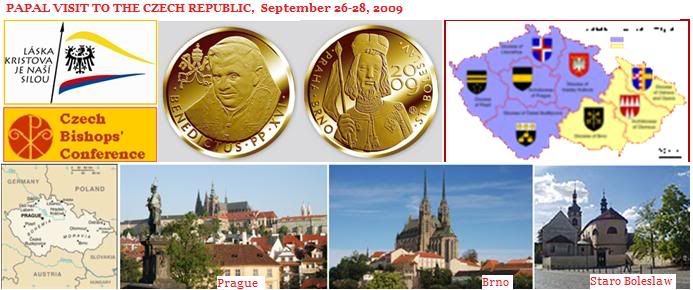 More security - and more crowds
More security - and more crowds
expected for Benedict XVI
than Czechs had for Obama

PRAGUE, July 26 (CTK) - Security measures during Pope Benedict XVI's visit to the Czech Republic in September will be even stricter than during U.S. President Barack Obama's visit in the spring, today's issue of the daily newspaper Pravo quotes police protection service head Lubomir Kvicala as saying.
"We expect many more people to come to public spaces, therefore the measures will be greater than during President Obama's visit," Kvicala said.
Obama attended an informal EU-United States summit in Prague last April.
The Pope will be in the Czech Republic on September 26-28.
Pravo writes that it will principally be the Mass that Benedict XVI will celebrate at the Brno-Turany airport on Sunday, September 27, that will place big demands on protection.
Brno Bishop Vojtech Cikrle estimates that some 120,000 people will attend it.
Obama's speech outside Prague Castle was attended by some 15,000 people.
|
| |
 28/07/2009 12:04 28/07/2009 12:04 |
|
| | | OFFLINE | | Post: 18.037
Post: 698 | Registrato il: 28/08/2005
Registrato il: 20/01/2009 | Administratore | Utente Senior | |
|

July 28
 St. Leopold Mandic (b. Croatia 1887, d. Padua 1942)
St. Leopold Mandic (b. Croatia 1887, d. Padua 1942)
Capuchin monk
'The Saint of Confession'
OR for 6/27-6/28:
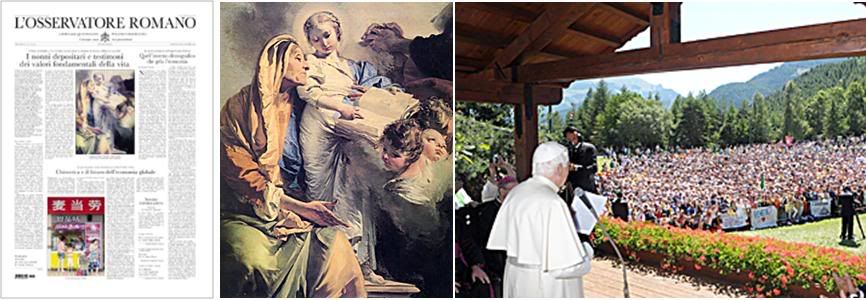 Illustration: Tiepolo, 'St. Ann and the girl Mary', Venice.
Illustration: Tiepolo, 'St. Ann and the girl Mary', Venice.
The Pope at Les Combes Angelus recalls priests' part in the plan of salvation and pays homage to
Grandparents as the repositories and witnesses of fundamental values
Other Page 1 stories: An editorial commentary on Europe's demographic winter which also freezes the economy;
China and the US start two-day economic summit in Washington. A long essay in the inside pages reviews the essays
collected in the book In difesa di Pio XII: Le ragioni della storia (In defense of Pius XII: The reasons of history)
edited by the OR's Giovanni Maria Vian.
THE POPE ON VACATION - DAY 16
[Modificato da TERESA BENEDETTA 28/07/2009 12:10] |
| |
 28/07/2009 12:25 28/07/2009 12:25 |
|
| | | OFFLINE | | Post: 18.038
Post: 699 | Registrato il: 28/08/2005
Registrato il: 20/01/2009 | Administratore | Utente Senior | |
|
 LES COMBES, July 28, 2009
LES COMBES, July 28, 2009 (Photos from Osservatore Romano):
 What a beautiful man, and what a great portrait!
What a beautiful man, and what a great portrait!
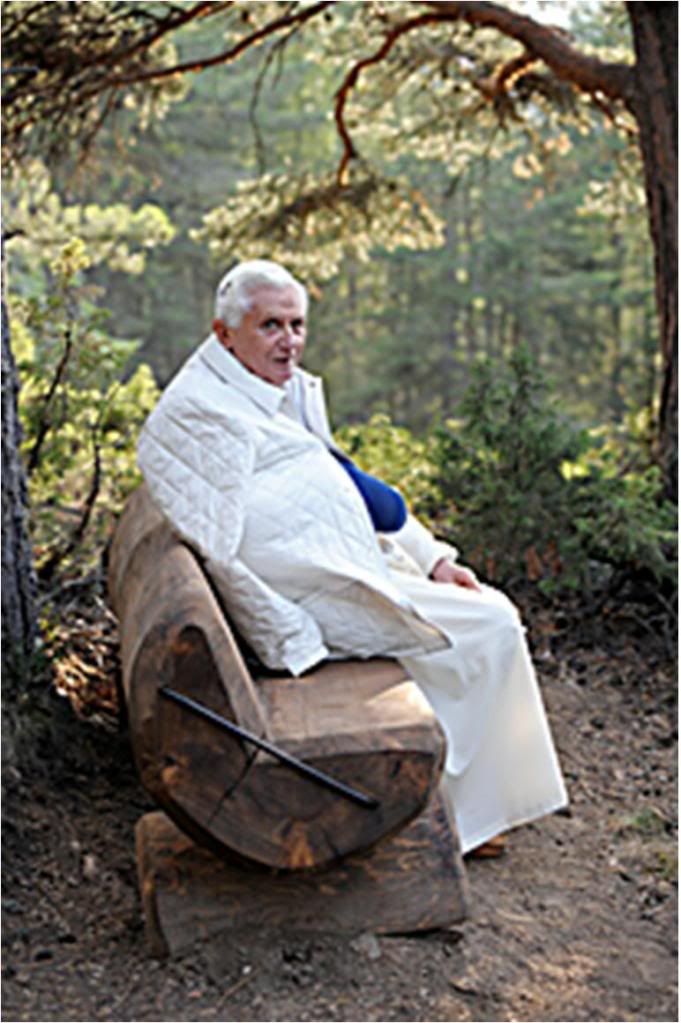
Variation on a theme.
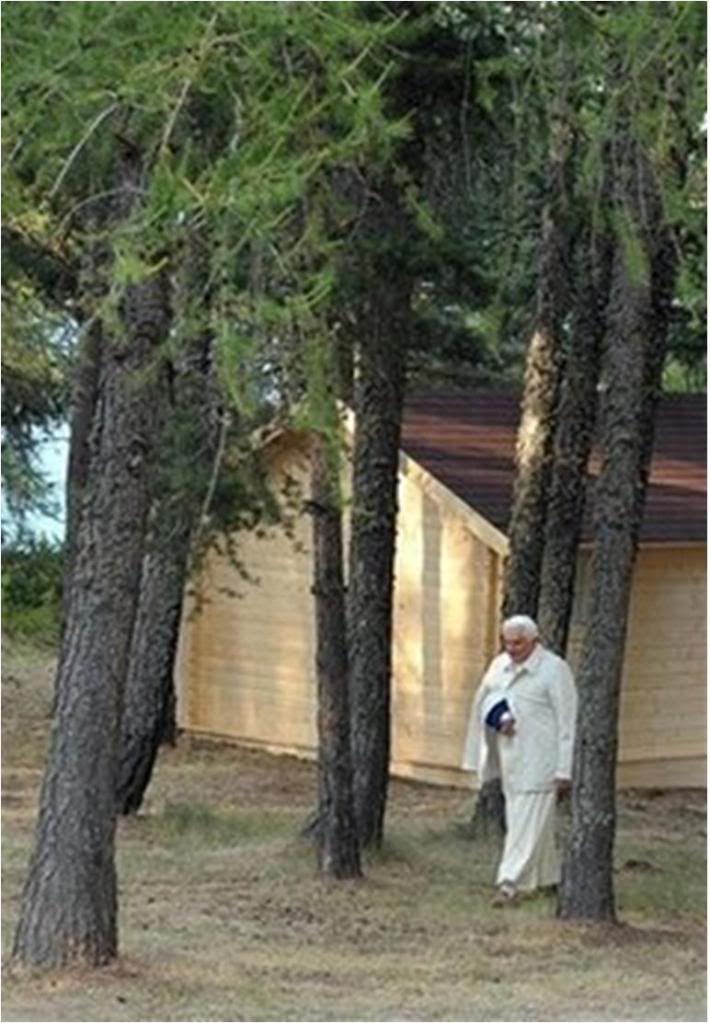
[Modificato da TERESA BENEDETTA 28/07/2009 22:34] |
| |
 28/07/2009 13:30 28/07/2009 13:30 |
|
| | | OFFLINE | | Post: 18.039
Post: 700 | Registrato il: 28/08/2005
Registrato il: 20/01/2009 | Administratore | Utente Senior | |
|
 Robert Moynihan, editor and publisher of INSIDE THE VATICAN magazine, has started a biweekly column for ZENIT called 'Inside the colonnade' of which this is the first.
Robert Moynihan, editor and publisher of INSIDE THE VATICAN magazine, has started a biweekly column for ZENIT called 'Inside the colonnade' of which this is the first.
Mr. Moynihan is a truly veteran Vatican observer, and his journalism is always very personal, and given his age, also tends to meander and indulge himself. A column is, of course, first and foremost, and always, a vehicle for personal opinion.
In this case, I believe Mr. Moynihan's 25-year friendship with the OR's Vian prevails over what one senses to be his own personal reservations about Obama, leading him to stretch and strain in order to justify Vian's obvious and (to me, journalistically) objectionable advocacy of Obama in any way, shape or form - before the Pope so clearly put his foot down at the July 10 meeting in the Vatican.
Barack and Benedict XVI:
The Vatican's approach to
a problem like Obama
by Robert Moynihan

ROME, JULY 27, 2009 (Zenit.org).- I first walked through Bernini's colonnade in May 1984. I was going to the Vatican Library to do research for a dissertation in medieval history.
By chance, my topic was very similar to the topic Joseph Ratzinger, now Benedict XVI, chose for his post-doctoral dissertation, The Theology of History in St. Bonaventure, and this gave me material for conversation when I met with Ratzinger on several occasions in the 1980s and 1990s.
On my very first visit to the Vatican library, I met a young scholar named Paolo Vian, son of the renowned Italian Catholic scholar, Nello Vian. Paolo graciously "showed me the ropes" during that summer at the library, helping me enormously.
I soon met Paolo's older brother, Gian Maria Vian, then a young professor of patristics at the University of Rome, and also a Vaticanista, reporting for the daily paper of the Italian bishops' conference, Avvenire -- the same Gian Maria Vian who today is the controversial editor of L' Osservatore Romano, known as the "Pope's newspaper."
In the years that followed, I had many occasions to talk with Gian Maria, a man of wide culture and ready wit, and I occasionally dined at his home with him and his wife (she suffered a long, debilitating disease, and sadly passed away several years ago).
So I have known Gian Maria Vian for 25 years, and can call him my friend. Indeed, I saw him several times during July in Rome, and we were able to speak at length.
The editor's recent positive attitude toward Obama has put Vian at the center of several critical debates in Catholicism today, and has led many to question even the "Catholicity" of L'Osservatore Romano.
In a series of articles this year, Vian and writers he chose have argued that Obama does not seem as much of a pro-abortion president as had been feared.
This has raised eyebrows among those active in the pro-life cause -- and sparked anger.
At the time of the emotionally charged debate over Obama's commencement address May 17 at Notre Dame, which was protested by over 80 U.S. bishops and boycotted by former U.S. Ambassador Mary Ann Glendon because of Obama's extreme pro-abortion record, Vian justified his more lenient position on the president: "We have noticed that his (Obama's) entire program prior to his election was more radical than it is revealing itself to be now that he is president. So this is what I meant when I said he didn't sound like a pro-abortion president."
[Yeah, well, Vian should not confine his reading to the New York Times and Time magazine. He should at least read the equally reputable (if not much more reputable at this point) C]Wall Street Journal which is rock-solid on economic and financial reporting, and fair and balanced in its political reporting and commentary. Because he may then begin to see the real Obama and his relentless personal agenda that the media Obamaniacs in the press have been too besotted and self-blinded to see.]
U.S. Catholic theologian Michael Novak described Vian's pro-Obama position as "star struck" and "teenage," and said that Vian's political perspective seems "like a blind observer of faraway events -- completely ignorant."
Vian defends himself by saying that the paper is adopting a "waiting and seeing" policy. [You can and should 'wait and see' without taking sides! Otherwise, what's to wait for if you've already decided to give him the benefit of the doubt against all doubtless evidence!]
He said, "We hope that Obama does not follow pro-choice politics; not because we want him to follow Catholic politics, but because we hope and want Obama to guide politics at the service of the weakest, and the weakest are the unborn, the embryos."
[The ultimate naivete is to believe that if you bend over backwards to be nice to a bigot, maybe he'll change his mind. Not for a person whose pro-abortion belief is bred in his bone!]
Have Vian, and the Vatican, been downplaying Obama's vehemently pro-abortion voting record and the pro-abortion record of his administration for "tactical" reasons? And, is such a position morally defensible?
Benedict XVI chose Vian to take over the editorship of L'Osservatore Romano in 2007.
Until two years ago, the paper's relationship to the Vatican was like that of Pravda to the Kremlin in the old U.S.S.R.
I remember how I and the other Vatican journalists would always look eagerly for articles signed only by three asterisks -- that was the not-so-secret "code" that those articles were "authoritative," approved at the very highest level of the Vatican.
But the rest of the paper was -- sorry to say -- boring.
"When I took over the paper," Vian says, "the Pope wrote me a letter in which he said that L'Osservatore had to be present in the cultural debate. The Pope asked me for more international coverage, more attention to the Christian East, and more space for women." [He didn't ask him to take sides, did he? Especially not when the side taken is morally equivocal at the very least - and on an issue that the Church considers non-negotiable.!]
So, Vian hired L'Osservatore's first-ever female staffer. [Moynihan is obviously lifting substantially from one of Vian's last interviews as a source for this part of his article, and perpetrating its factual mistakes - small ones, but factually wrong nonetheless. Vian hired the first female to be a regular contributor to the OR, who, more importantly, is also Jewish; the OR had female staffers before that, including the lady recently promoted to be the editor of the German edition.]
And he adds: "When the deputy editor and I were invited to see the Pope to talk a bit about the paper three weeks after we were appointed, he gave us to understand that he'd like to see a few more pictures in it."
Vian decided to use color photographs every day on the front and back. But the new editor's impact has been most significant in the paper's content.
A month before President Obama's scheduled visit to see the Pope on July 10, Vian published an editorial that took a positive view of Obama's first 100 days.
Conservative Catholics in the United States and elsewhere were appalled that, despite Obama's moves to provide greater access to abortion and stem-cell research, the paper was not denouncing Obama. [Not to denounce in a blanket way, no, because that would be equally unfair. But specifically, at least not to have skewed the presentation as he did to give the impression that in fact, Obama had not carried out any anti-life measures when he so clearly has!] There were calls for Vian to resign.
When I spoke with Vian a few days ago, I asked him about this controversy. He told me that he still has the "full support" of the Vatican's Secretariat of State. (In fact, Vian is a personal friend of Cardinal Tarcisio Bertone, the Pope's secretary of state .)[Who recommended him to the Pope].
What can explain Vian's position -- and, by implication, the position of the Secretariat of State, and, perhaps, of the Pope himself?
Vian told me that the "big picture" needs to be kept in mind, that the Holy See's agenda, while always and unswervingly pro-life, nevertheless includes many other issues, such as social justice, disarmament, the Middle East and Cuba. [ Yes, but pro-life is non-negotiable, whereas political issues that do not involve indiscriminate killing - in war and violence or by contraception, abortion, euthanasia - are subject to pragmatic considerations of Realpolitik.]
Vian's position illustrates the considerable differences between the European and American viewpoints on many critical issues of our time. The Europeans (like Vian) focus on points of agreement, and the Americans (like Vian's critics) focus on points of disagreement. [DUH! If people agree, there is nothing to dispute. It's unrealistic and completely counter-productive to sweep points of disagreement - especially vital, pivotal issues such as the defense of life - under the rug!]
I do think Vian -- and even the Secretariat of State -- may be "naïve" about Obama and his intentions.
But I also believe that Americans can become so intent on one grave moral injustice (abortion and the manipulation of human embryos, both of which are always profoundly wrong) that they can ignore other areas of possible agreement.
[NO! Absolutely not. The American Catholics who were enraged that the OR was bending over backwards for Obama do not rule out cooperation and agreement in other areas at all.
What they were protesting is that the Vatican - until the Pope himself stepped in - seemed to be giving a pass to Obama's unmistakable, undeniable pro-abortion militancyto the point of not reporting at all on the opposition by US bishops, including the president of the USCCB, to Notre Dame giving an honorary degree to Obama.
The opposition was to the flagrant one-sidedness - on the wrong side - of the editorial position that Vian took. By any journalistic standard, that was wrong, and by plain standards of decency, blatantly unfair!
It is exactly the kind of advocacy journalism for the liberal side that the New York Times and other major American media have taken since Watergate and which is now killing their business and their credibility as they become more incapable of reporting both sides fairly and equitably.]
Is it possible to find a balanced solution, giving proper weight to both points of agreement and disagreement?
The best approach may be the one chosen by Benedict XVI himself in his meeting with Obama on July 10.
I was in the Vatican on that occasion. I saw Obama as he stepped out of his car, and I attended the press conference after the meeting was over.
And two points were clear: the Pope was receiving Obama with warm friendship, and yet, he was not compromising the truth of the Church's teaching about life.
In fact, he made it a special point to hand the president a Vatican document which explains in detail the reasoning behind the Church's teaching that abortion is always wrong, and experimentation on human embryos is always a violation of the dignity of human life.
The booklet, Dignitas Personae (dignity of a person), condemns artificial fertilization and other techniques used by many couples, and also says human cloning, "designer babies" and embryonic stem-cell research are immoral.
The document defends life from conception to natural death, and a Vatican statement issued after the meeting said the topics discussed included "the defense and promotion of life and the right to abide by one's conscience."
The Pope's private secretary told reporters after the meeting: "This reading can help the president better understand the Church's position on these issues."
We do not know if Obama has read that booklet. (That is something I would like to know, because the arguments in that booklet are compelling.) [What will you bet he didn't so much bother as to open it? Or perhaps he got around to flipping a few pages over, followed by a few choice remarks about the obscurantism of the Church?]
The point is, the possibility of reaching Obama with a reasoned argument in defense of life was increased by the way Vian presented Obama's position during the spring.
[EXCUSE ME???? 'A reasoned argument in defense of life' with someone who advocates contraception and abortion as basic human rights???? And whose proposed healthcare reform bill would mandate 'counselling every five years for end-of-life choices' for all Americans over 65 - than which there is no more shameless way to mandate euthanasia???? Who's being naive here? Dr. Moynihan, read the US papers, please. Don't insulate yourself in Europe.]
Obama was entering the Vatican on July 10, not as an enemy, but as a human being, to whom the Pope could appeal as one man to another.
{EXCUSE ME ONCE AGAIN! But the Pope would have treated him in exactly the same way whether the OR had endorsed him or not! As he treated Hugo Chavez of Venezuela when he was at the Vatican. It's demeaning the Pope himself to even suggest that he could possibly treat a guest at the Vatican as an enemy. This is the worst and most irrelevant argument Moynihan could have thought of to justify Vian's obviously deliberate (self-admitted) choice to stack the cards for Obama in the newspaper he edits!]
Naïve? Perhaps. Time will tell. And the Church will be ready to defend her beliefs if Obama makes clear that he will persist on a course that is directly opposed to those teachings.
Interestingly, on July 23, it was reported that Obama's health care legislation may be held up due to the opposition of a group of conservative Democrats in the U.S. House who have vowed not to vote for any bill that doesn't include explicit language banning the use of federal funds for abortion.
They, as well as most Republicans, charge that abortions will otherwise increase if more women have insurance coverage that pays for the procedure.
Obama, when asked if he would favor federally subsidized insurance plans that covered abortion, said, "As you know, I'm pro-choice. But I think we also have the tradition of, in this town, historically, of not financing abortions as part of government-funded health care."
[Of course, he would deny it. He's proven very good at talking out of both sides of his mouth these past two and a half years that he's been the 'center of the world'. But right there, in the statement Moynihan quotes is a barefaced lie!
How can he say that abortions have never been financed by government-funded health care when his very first executive action as president was to repeal George W. Bush's ban against using US government funds for any international program that promoted abortion for whatever reason - usually as part of healthcare packages and development aid? Ronald Reagan banned such funding, Democrat Clinton restored it, Bush banned it again, and now Democrat Obama has restored it back.
And let's not even talk about how the various versions of Obama's healthcare reform proposed by Congressional Democrats contain both hidden and overt references that would mandate health insurance plans to pay for all abortions, whether they are medically justified or not!
No, Mr. Moynihan, you have to be more rigorous in screening self-serving statements, especially when they are so obviously false!]
Hearing this, pro-choice activists are concerned. "We're certainly worried," says Marilyn Keefe, director of reproductive health programs at the National Partnership for Women and Families. "Abortion is basic healthcare for women. We're worried about the possibility that existing coverage will be rolled back."
[You really believe they are worried about that aspect? With solid Democratic pro-choice majorities in both houses, who can easily argue that because of Roe v. Wade, abortion is a human right and therefore should be covered by medical insurance?]
Perhaps the Pope's meeting with Obama had some good effect. [Dear Mr. Moynihan, maybe you've lived outside the United States too long!]
[Modificato da TERESA BENEDETTA 29/07/2009 05:15] |
| |
 29/07/2009 00:12 29/07/2009 00:12 |
|
| | | OFFLINE | | Post: 18.040
Post: 701 | Registrato il: 28/08/2005
Registrato il: 20/01/2009 | Administratore | Utente Senior | |
|
 Day 16 in Les Combes:
Day 16 in Les Combes:
Eve of departure
Translated from
the Italian service of

July 28, 2009

Benedict XVI by now is having his last night's sleep in Les Combes before he leaves tomorrow afternoon for Rome and Castel Gandolfo. [I hope they have since provided his bedroom and bathroom with a night light or replaced the light frame switches with something phosphorescent. Can't risk him taking another stumble!]
Alessandro Di Carolis spoke to Fr. Federico Lombardi today:
FR. LOMBARDI: The Holy Father spent a day in great tranquillity, carrying on his usual reading, reflection, prayers, his walk after lunch and in the early evening.
Tomorrow, he will greet all the persons - and there are not a few - who have worked together to insure his safe and peaceful stay here at Les Combes.
Last night, there was the traditional dinner at the Salesian colony to thank them, with the attendance of the civil and military authorities of the region, the province and the municipality of Introd, as well as the medical personnel from the Parini Hospital in Aosta.
Mons. Gaenswein conveyed to them the Holy Father's greetings, who said he looked forward to thanking them personally tomorrow.
It may not look like it but even a papal vacation still requires a lot of logistical and security organization, and everyone involved carries out his task willingly and even gladly, even if the work is complex.
Over the years, an atmosphere of great cordiality and collaboration has developed among the Vatican security personnel responsible for close-in protection of the Pope, the personnel of the Salesian colony, the local forces of law and order, and the local authorities most directly concerned with the Pope when he is here.
That was evident last night in the remarks made by the president of the region, Augusto Rollandin; the president of the Regional Council, Albert Cerise, and the mayor of Introd, Osvaldo Naudin, whom the Pope greeted two weeks ago as 'the eternal mayor' since has has been mayor for the past 30 years.
In this regard, the municipal council of Introd formally announced yesterday that they wish to confer honorary citizenship on the Holy Father...
Yes they did. Now, the Pope must give his formal and explicit acceptance, after which, some time in the next few months, a delegation from Introd will come to Rome to officially confer the honor. That has been the SOP with the German towns and cities who made the Pope an honorary citizen. [But in Bressanone last year, the conferment was done just before the Pope left at the end of his vacation there.]
Of course, the Pope is happy to accept these honors because they represent to him the warmth and affection of the communities concerned.
There's a fairly long anticipatory article on preparations at Castel Gandolfo for the Pope's stay in tomorrow's issue of L'Osservatore Romano, along with his public program for the next few days, but for now I will post the CNS blog based on it:
 Pope’s piano tuned,
Pope’s piano tuned,
even if he can’t play for now
Posted on July 28, 2009
by Cindy Wooden

VATICAN CITY — The director of the papal villa at Castel Gandolfo told the Vatican newspaper that preparations are almost complete for the pope’s expected arrival tomorrow evening: bushes have been re-potted, trees have been trimmed, flowers have been planted, walls have been painted and — he said — a piano tuner has come and gone.
Severio Petrillo, director of the villa — which includes the papal residence as well as gardens and a working farm — said he knows the pope has to wear a cast for another 20 days or so.
But the Pope’s brother, Msgr. Georg Ratzinger, is arriving, too, [on Saturday]. And he’s a musician. For years, he was the director of the famous Regensburg Boys’ Choir. And, besides, Petrillo said, piano playing could be part of the physical therapy the Pope will do once the cast is off [after August 15].
Petrillo also said that the Pope will meet swimmers, divers, water polo players and other athletes participating in the July 17-Aug. 2 FINA World Championship in Rome.
He will lead the Sunday noon Angelus from the inner courtyard of the Appostolic Palace, as usual. [Wooden omits the information that on Sunday afternoon, a German orchestra (not yet identified) will present a concert in the inner courtyard of the Apostolic Palace for the Holy Father and his brother.]
The Pope’s weekly general audience Aug. 5 also will be held at the papal villa, rather than at the Vatican, he said.
[Further general audiences during the summer will be held at Castel Gandolfo or at the Vatican depending on the number of requests for tickets.]
I am curious why CNS chose to run this item as a blog and not as regular news!
[Modificato da TERESA BENEDETTA 29/07/2009 08:24] |
| |
 29/07/2009 05:01 29/07/2009 05:01 |
|
| | | OFFLINE | | Post: 18.041
Post: 702 | Registrato il: 28/08/2005
Registrato il: 20/01/2009 | Administratore | Utente Senior | |
|

 Is China showing signs
Is China showing signs
of a thaw towards the Vatican?
by GIACOMO GALEAZZI
Translated from

July 26, 2009
VATICAN CITY - The Chinese government is 'opening up' towards the Vatican by postponing till next year the selection of a new president for the 'patriotic' bishops.
A Beijing 'conclave' for this purpose has reportedly been postponed six months in the hope that an agreement can be reached with the Vatican on the most outstanding issues regarding the Catholic Church in China.
This is seen as a belated consequence of Pope Benedict XVI's letter to the Catholics of China in June 2007, in which he urged all Chinese Catholics to fulfill their duties as Chinese citizens as well.
According to La Stampa sources, high-level meetings between Vatican officials and the Chinese have just ended, and as a sign of openness, the Chinese government has decided to postpone an important nominating conference to 2010.
Besides the head of the official bishops' conference, five new episcopal appointments will also be decided at that meeting for the dioceses of Taizhou in the Zhejiang region; Sanyuan in Shaanxi; Hohhot in Inner Mongolia; and Wuhan and Haimen in Jiangsu.
In effect,Beijing will defer chossing new bishops until coming to an agreement with the Holy See. Government sources in Beijing said that the Holy See has been informed that "in order to widen the possibility of choices, the convocation has been postponed to 2010".
The official justification is the celebration of the 60th anniversary of the founding of Communist China to which 'a representation of personalities in the religious field' will be invited - including the bishops of Hongkong and Macao who he remained faithful to Rome all this time.
According to the statutes of the 'official' Church in China controlled by the government, its national assembly is convoked every five years, but in special cases, it may be held earlier or later.
After the death of the previous president, Bishop Fu Tie Shan, in April 2007, the authorities had already decided to wait until the 2009 national aseembly to choose his replacement. And four months ago, the vice president of the patriotic Association, Liu Bainian, had announced the convocation of the National Assembly and the College of Bishops of the official church in the second half of 2009.
And so, this new postponement in the hope of reaching an agreement with the Vatican within the next several months is an encouraging sign.
The Pope's July 2007 letter opened up new scenarios for Rome and Beijing, which even includes a trip to China by the Pope, even if his letter reiterated the right of the Vatican to nominate bishops and criticized the methods of the government-sponsored Patriotic Association which runs the affairs of the 'official' Church.
In the Catholic world, there has been an ongoing dispute over the interpretation of the Pope's letter.
Cardinal Joseph Zen, who recently retired as Bishop of Hongkong, opposes the interpretation of Belgian missionary and China expert Fr. Heydrickx who says the Pope called on underground Chinese Catholics to come out and join the 'official' Catholics.
After the Pope's letter, there have been no further illegitimate episcopal ordinations (not concurred with by the Vatican) of 'patriotic' bishops, nor any of clandestine bishops either.
All the bishops ordained since then, including the new Bishop of Beijing Li Shan, have had the approval of the Vatican through a practical modus vivendi, even without a formal agreement to this effect.
The outstanding issues at this point are, on the part of Beijing, that the Holy See should end its diplomatic relations with Taiwan [a point which the Vatican has conceded informally], and 'non-interference' in China's internal affairs [a murky demand, since anything the Vatican has to say about the Catholic Church in China could easily be considered by Beijing as just such interference]; and on the part of the Vatican, an end to the control of the Catholic Church in China by the Patriotic Association, and the Pope's freedom to name Catholic bishops.
[Modificato da TERESA BENEDETTA 29/07/2009 05:02] |
| |
 29/07/2009 07:42 29/07/2009 07:42 |
|
| | | OFFLINE | | Post: 18.042
Post: 703 | Registrato il: 28/08/2005
Registrato il: 20/01/2009 | Administratore | Utente Senior | |
|
 As announced last week, Cardinal Tarcisio Bertone, Vatican Secretary of State, was invited by the Italian Senate to present the Pope's third encyclical to its members. He did Tuesday, 7/28, as scheduled, and L'Osservatore Romano carries the full text of his lengthy presentation in its 7/29/09 issue.
As announced last week, Cardinal Tarcisio Bertone, Vatican Secretary of State, was invited by the Italian Senate to present the Pope's third encyclical to its members. He did Tuesday, 7/28, as scheduled, and L'Osservatore Romano carries the full text of his lengthy presentation in its 7/29/09 issue.
A House of Parliament inviting a high-ranking Church representative the Vatican to present a Church document to its members is a phenomenon that can only happen in Italy.
Since Bertone's full speech takes some translating, I will use for now Vatican Radio's account of the speech, which is far shorter.
Cardinal Bertone presents
CIV to the Italian Senate
Translated from
the Italian service of

July 28, 2009

Cardinal Bertone this morning presented to the Italian Senate, at its invitation, the Holy Father's new encyclical Caritas in Veritate.
"Those who have the delicate and privileged responsibility of representing the Italian people," he said, "can find in the words of teh Pope an inspiration that is both profound and elevated for carrying out their mission, and thus to respond adequately to the ethical, cultural and social challenges which face us today".
Amedeo Lomonaco reports further:
The Secretary of State dwelt on the propulsive force of of truth and love, saying that only by being anchored to these two fundamental criteria is it possible to construct 'authentic good' and respect the natural law 'inscribed in the heart of man'.
He pointed out how truth and love, which should be inseparable, are the cardinal points of Benedict XVI's reflections on the present socio-economic situation.
An important message of the encyclical, said Bertone, is an invitation to overcome the now obsolete dichotomy between the economic and social spheres.
"Economic activity is not something detached and alien from the cardinal principles of the social doctrine of the Church which are the centrality of the human being, solidarity, subsidiarity and the common good."
He said the Church's social doctrine reminds us that a good society is an outcome of the market and of freedom. And that the Church proposes a multidimensional humanism, in which the market is neither fought against nor 'controlled' but seen as an important element in the public sphere when it conforms to basic ethics.
Additionally, Bertone pointed out, there are demands arising from the principle of fraternity which cannot be avoided "nor simply confined to the private sphere or to philanthropy".
" Caritas in Veritate helps us to be conscious that society has no future unless it abides by the principle of brotherhood - that is, it cannot progress if it exists and develops only on the logic of giving in order to have more, or even giving out of duty. That is why neither the liberal-individualistic view of the world nor the state-centered view of society are proper guides to bring us out of the quicksands in which our society today is mired".
He said the social doctrine of the Church "must not be considered as yet another ethical theory along with so many others that are already out there", but as 'a common grammar' for all social theories because it is based on a specific point of view, that of "taking care of human good'.
Efficiency and justice, he said, do not suffice to assure human development:
"The message of Caritas in Veritate is that we should think of gratuitousness, giving freely, and therefore of brotherhood, as the sign of the human condition and thus, to see in the exercise of giving the indispensable premise so that the State and the market can function with the common good as the goal.
"Without parties that give freely, certainly there can be an efficient market and an authoritative state (even a just one), but they certainly will not help human beings to realize the joy of living."
He also dwelt on some factors that led to the present crisis:
- The radical change in the relationship between financing and production of goods and services have resulted in a persistent demand for ever more brilliant persistent financial returns.
- The diffusion of the ethos of efficiency as the ultimate criterion of judgment has resulted in legitimizing greed as a civic virtue.
- The crisis poses a double challenge to government authorities: criticism of state intervention does not invalidate the central role of the state as a regulator. But public authorities should allow the birth and reinforcement of a pluralist financial market.
It is hoped, said the Cardinal, that the encyclical may find the attention that it deserves and "bring positive and abundant fruits for the good of every human being and the entire human family, starting with our dear Italian nation".
Senate President Renato Schifani, for his part, affirmed that the encyclical proposes a new "lexicon of peace based on the word hope" and in this context, he said, a profound change in international institutions is needed:
"The Encyclical opens a new millennium after a long period of crisis and is an occasion to rethink the global economy, to find new rules for a society in profound transformation".
CNA has this account:
Cardinal Bertone offers encyclical
as response to society's challenges

Vatican City, Jul 28, 2009 (CNA) - The Italian Senate took time on Tuesday to hear about a topic not usually on their agenda — a papal encyclical.
Cardinal Tarcisio Bertone, the Vatican's Secretary of State, addressed the senators about Caritas in Veritate and how it can help them respond to the "ethical, cultural and social challenges of today."
The speech by Cardinal Bertone was delivered at the invitation of the president of the Italian Senate on Thursday morning.
Cardinal Bertone highlighted some of the anthropological and theological aspects of the Pope's latest encyclical, which is devoted to encouraging countries to promote the true development of man, a development that encompasses the material, spiritual and moral arenas.
The Secretary of State also recalled that in 2004 the then Cardinal Joseph Ratzinger had given a "lectio magistralis" in the Senate library on the theme: "Europe. Its spiritual roots, yesterday, today and tomorrow."
On that occasion, he reminded, the future Pontiff had focused on certain themes that are now contained in his third Encyclical, such as "the affirmation of the profound reasons behind the dignity of individuals and their rights," and marriage and the family as elements that have forged European identity.
The cardinal said that he believes the representatives of the Italian people will find the Pope's words to be "an exalted and profound source of inspiration when carrying out their mission." Hopefully, the encyclical will enable them to respond "adequately to the ethical, cultural and social challenges of today."
[Modificato da TERESA BENEDETTA 29/07/2009 08:12] |
| |
 29/07/2009 13:41 29/07/2009 13:41 |
|
| | | OFFLINE | | Post: 18.043
Post: 704 | Registrato il: 28/08/2005
Registrato il: 20/01/2009 | Administratore | Utente Senior | |
|

Wednesday, July 29
 Vermeer, Christ in the House of Mary and Martha
St. Martha
Vermeer, Christ in the House of Mary and Martha
St. Martha
Sister of Lazarus and Mary
OR today.
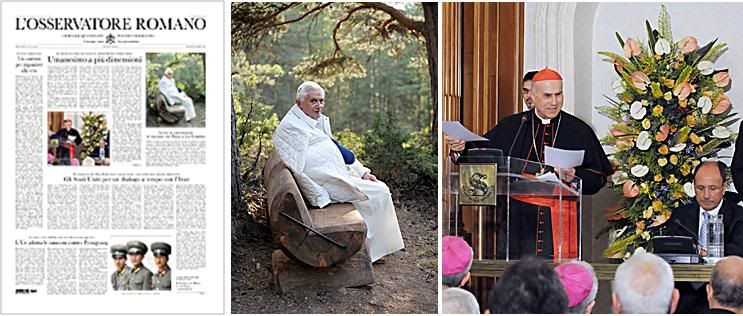
On Page 1, a note that the Pope's vacation in Les Combes ends today. Other stories: Cardinal Bertone's presentation of Caritas
in veritate to the Italian Senate (the full text of his address and the greeting by the Senate President are published in the inside
pages, along with an essay on the film Wall Street and its famous line 'Greed is good', cited in Bertone's text); the Chinese-
American economic summit in Washington; US Defense Secretary Robert Gates tries to reassures Israel on Obama administration's
attitude towards Iran; and the European Union adopts sanctions against North Korea.
THE POPE ENDS HIS VACATION TODAY -
LEAVES LES COMBES FOR CASTEL GANDOLFO
[Modificato da TERESA BENEDETTA 29/07/2009 16:32] |
| |
 29/07/2009 16:49 29/07/2009 16:49 |
|
| | | OFFLINE | | Post: 18.044
Post: 705 | Registrato il: 28/08/2005
Registrato il: 20/01/2009 | Administratore | Utente Senior | |
|
 ARRIVEDERCI TO LES COMBES - Part 1:
ARRIVEDERCI TO LES COMBES - Part 1:
POPE DRAWS A LESSON FROM HIS FALL

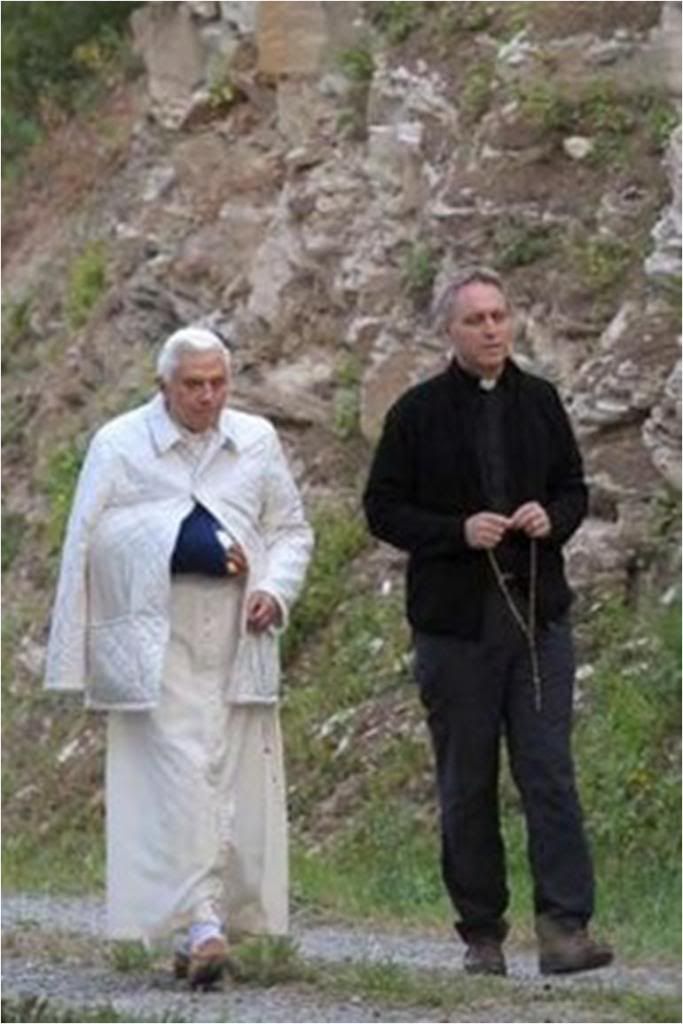 'Rosary' walk with Mons. Gaenswein, 7/28/09. The third man in the photo below is the Pope's valet, Paolo Gabriele.
'Rosary' walk with Mons. Gaenswein, 7/28/09. The third man in the photo below is the Pope's valet, Paolo Gabriele.
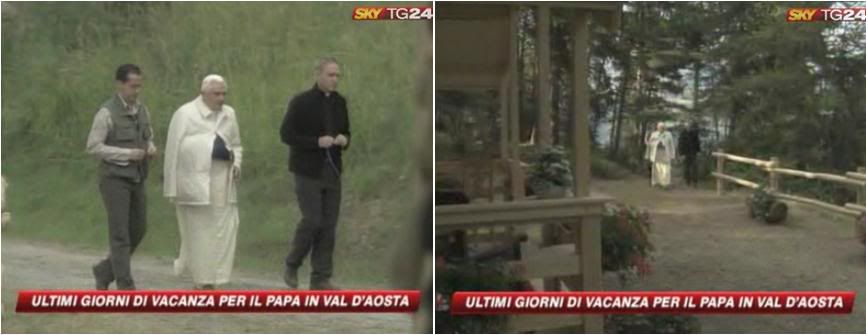
LES COMBES, Italy, July 18 (AP) — Pope Benedict XVI said Wednesday that his "guardian angel" let him down when he fell and broke his wrist earlier this month, but that the angel was clearly acting "on superior orders."
The Pope thanked law enforcement officials for being "like angels," as he prepared to depart Les Combes, the Alpine resort where he tripped and injured his wrist 10 days ago while on vacation.
"Unfortunately, my own guardian angel did not prevent my injury, certainly following superior orders," Benedict said.
"Perhaps the Lord wanted to teach me more patience and humility, give me more time for prayer and meditation," the Pope added.
Benedict leaves Les Combes, near the French border, later Wednesday to spend the rest of the summer in Castel Gandolfo, a papal retreat near Rome.
The 82-year-old Pope fell in his mountain chalet and fractured his right wrist. He had surgery at a local hospital on July 17 and spent the rest of his two-week vacation in a cast.
He kept up his limited public schedule and seemed to move with ease, though the injury made writing by hand difficult.
The Pontiff had hoped to make progress during the vacation on the second installment of his two-book project on Jesus of Nazareth.
After his accident, the Pope, who likes to write by hand, used a tape recorder to collect his thoughts.
A fuller report is given in this account
translated from the Italian service of

July 29, 2009
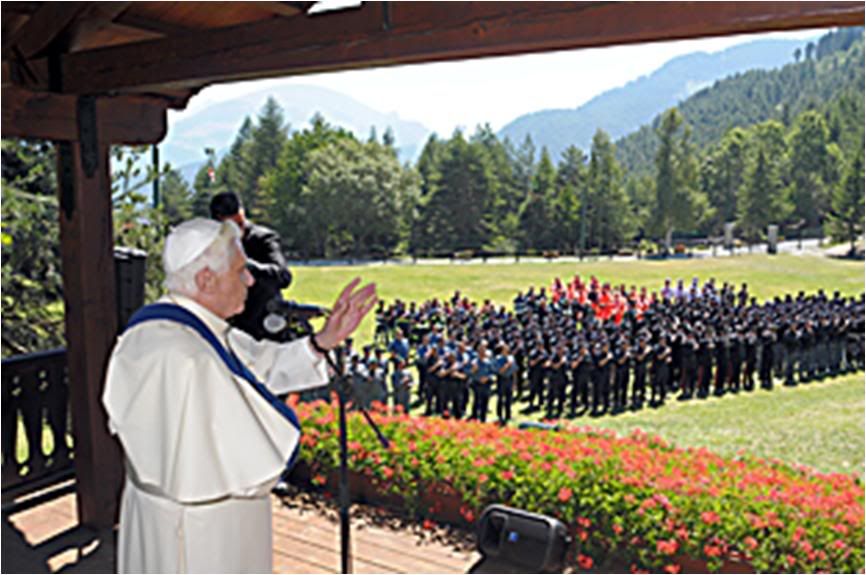
He compared them to "guardian angels, discreet and efficient", as Pope Benedict said thank you and farewell today to the security forces and other persons assigned to look after his safety and privacy in Les Combes for the past 17 days.
During the noonday gathering at the Plain du St. Pere, the open meadow next to the chalet that served as his vacation home for the third time, the Holy Father jested about his broken right wrist, as Alessandro Di Carolis further reports:
A brief and thankful greeting with a touch of humor. Words from the heart which also brought a smile to his listeners.
This was how Benedict XVI said farewell today to hundreds of persons who provided him with a near-invisible network of protection and privacy since he arrived in Les Combes on July 13.
They were the policemen, Civilian Protection workers and firemen deployed by the regional and local authorities, along with members of the Vatican Gendarmerie, Police Inspectorate and health services.
"Dear friends, at the end of these two weeks of vacation, I can only say with all my heart 'Thank you' for your service that has been so competent, discreet and efficient.
"You have been like angels - they are invisible but efficient all the same. So you were for me - mostly invisible but always efficient."
He said he had spent days of rest immersed in 'a celestial peace', a silence interrupted only, he said, "by the 'sounds of the Creator', such as those of the birds.
[ Avvenire provides the exact quote: "I have been living in celestial peace, into which no disturbance couldenter, but rather, so many good things, material and immaterial". He added, "So many cakes and cheeses and wines".]
He praised the beauty of Nature in Les Combes which he said he enjoyed despite the accident to his wrist. He then took up the subject of angels again - guardian angels specifically - with humor and profound spirituality:
"Unfortunately, my guardian angel did not prevent my accident, surely following 'higher orders'... Perhaps the Lord wished to teach me to be more patient and humble, to give me more time for prayer and meditation."
Around 4:30 this afternoon, the Pope will have a farewell meeting with the Bishop of Aosta, Mons. Giuseppe Anfossi, along with regional and municipal officials.
Then he will take the helicopter to Torino-Caselle airport, from which the papal party will take a regular airplane to Rome's Ciampino airport.
From there, the Pope will be driven directly to Castel Gandolfo where he will spend the rest of the summer.
Sergio Centofanti spoke to Father Federico Lombardi, who gave further details about the noonday gaterhing:
FR. LOMBARDI: This a necessary and beautiful ritual at the end of the Pope's summer holiday. Emerging from the residence, the Pope first met with a group of about 35 young Salesians from the Inspectorate of Piedmont who are undertaking a summer course in Valle D'Aosta. The Pope greeted them and their leader with great warmth
He then proceeded towards the kiosk from which he led the noontime Angelus last Sunday, in front of which were ranged all the various corps that had provided security and logistical services for the Pope's vacation.
The Pope greeted them in high spirits, very affectioNately, and referred to them as guardian angels, while making a humorous reference to his own guardian angel.

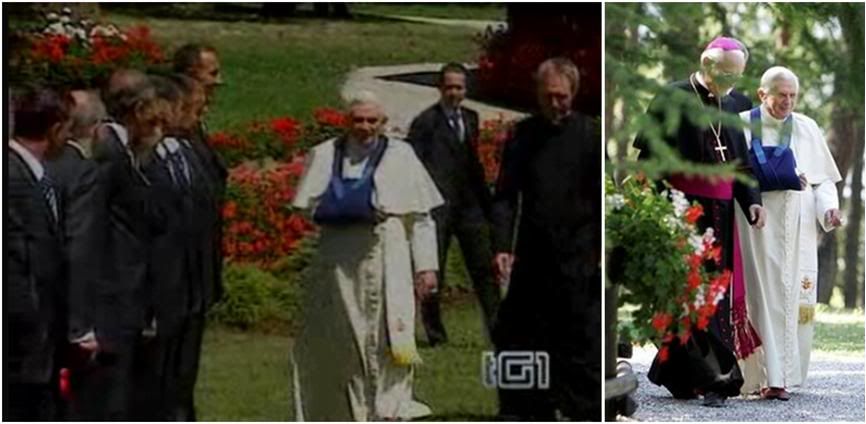
He then walked out to the field and had his photograph taken with each corps - the policemen, the firemen, civilian protection, forest rangers, Alpinists, canine teams, the army and the state police... Every group present had its picture taken with the Pope.
Even the journalists who were there also had their photo taken with the Pope, and were able to exchange a few words in a light way.
I would say the Pope was in top form: despite his small accident, his vacation here obviously had the desired effects.
How would you evaluate this vacation?
Very positive. As everyone knows, it turned out to be somewhat different from expectation, so perhaps, the Pope was unable to do as much work on JESUS OF NZARETH, part 2, as he thought he would, but he had more time for meditation, reading and prayer as a result.
As the Pope implied earlier, there is always something to be learned, and even his accident was spiritually fruitful for the Holy Father.
THE POPE AND THE NEWSMEN

LES COMBES (AOSTA), July 29 (Translated from ANSA) - After greeting the security personnel adn others entrusted with looking after him during his vacation, Benedict XVI also exchanged a few words with journalists present.
He recalled that on his previous vacation in Les Combes in 2006, the war in Lebanon was going on, and he expressed the hope that the peace that has since come upon that country "may be consistent, that it may grow, and that it will be at peace finally".
He said in jest, "But this year, you had little to write about. Even though, one could always invent... Though this" - showing his right forearm in a cast - "was enough of a happening. We did not need more [bad news]..."
He added: "I know you were concerned. The Lord will help us."
When he was asked if he had a good holiday, he said, "Of course, with this beautiful Nature...."
He then posed for pictures with some of the newsmen's children, calling them 'journalist shoots'.
To the children of the Avvenire correspondent, he said: "I always read Avvenire - I read it very day."
[Modificato da TERESA BENEDETTA 30/07/2009 06:15] |
| |
 29/07/2009 18:38 29/07/2009 18:38 |
|
| | | OFFLINE | | Post: 18.046
Post: 707 | Registrato il: 28/08/2005
Registrato il: 20/01/2009 | Administratore | Utente Senior | |
|
 ARRIVEDERCI. LES COMBES - Part 2:
ARRIVEDERCI. LES COMBES - Part 2:
The Pope has left


LES COMBES (AOSTA), July 29 (Translated from ANSA) - Benedict XVI has left Les Combes by helicopter after saying farewell to the people of this mountain region at 1300 meters altitude.
"Bon voyage, Holiness, and come back", they called out to him, and he answered: "God willing, I hope to. Let us hope so".
Earlier, in saying his farewell to the local authorities, regional president Augusto Rollandin gave him a wooden statue of St. Anselm, whose 900th death anniversary the region is marking this year.
Introd Mayor Osvaldo Naudin gifted the Pontiff with another wooden statues, this one of St. Lawrence, patron of Introd.
Then, before proceeding to the helicopter, he greeted the local people who were assembled at the nearby Salesian vacation colony. Among them, 12 children from the local day care center accompanied by their teachers.
AS they had done when he arrived last July 13, they gave him a quadrilingual greeting in Italian, French, German and the Valdostan dialect. They also presented him with an edelweiss plant and an album of their drawings.
Earlier pictures:
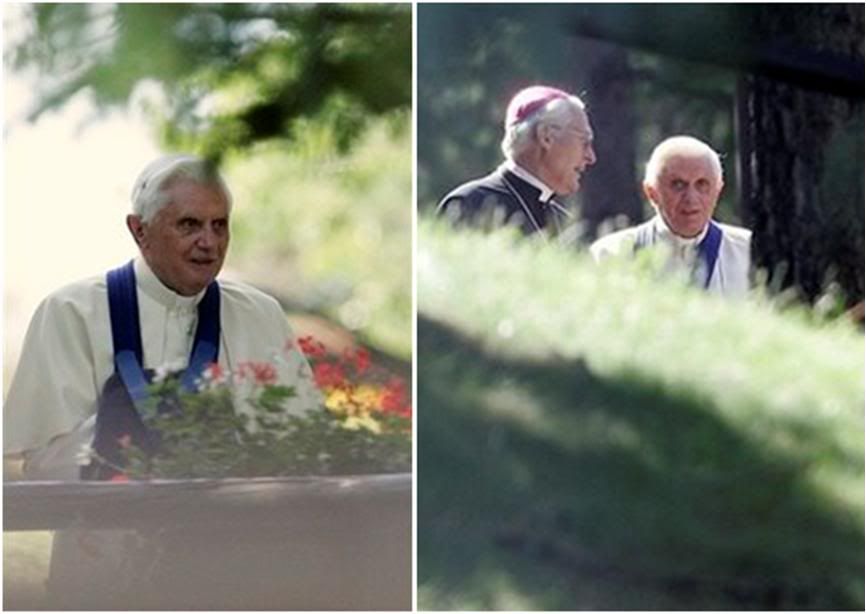
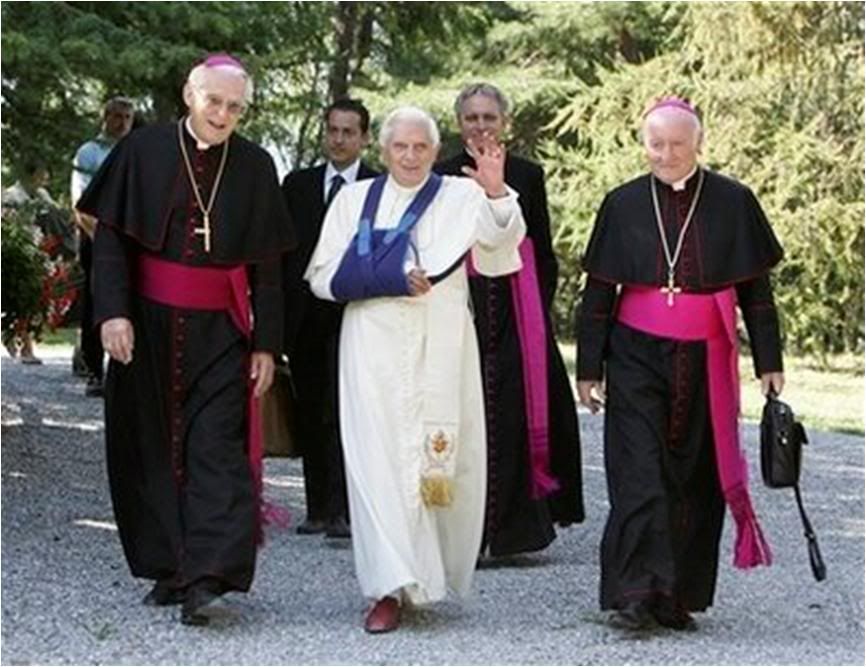
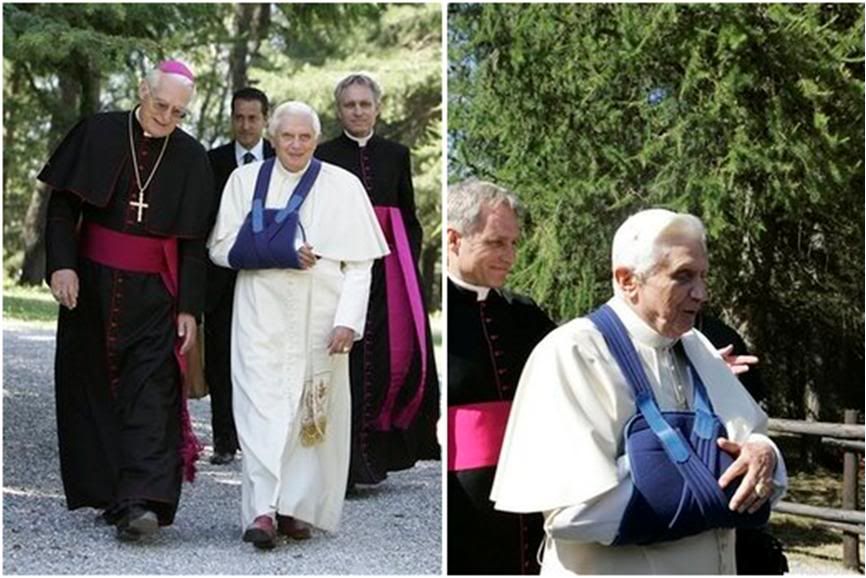

 The photos in the bottom panel were captured from a TG1 videoclip, which for some reason had atrocious lighting though it was shot in early afternoon on a clear bright summer day.
The photos in the bottom panel were captured from a TG1 videoclip, which for some reason had atrocious lighting though it was shot in early afternoon on a clear bright summer day.
 AND BUONA SERATA, CASTEL GANDOLFO!
AND BUONA SERATA, CASTEL GANDOLFO!
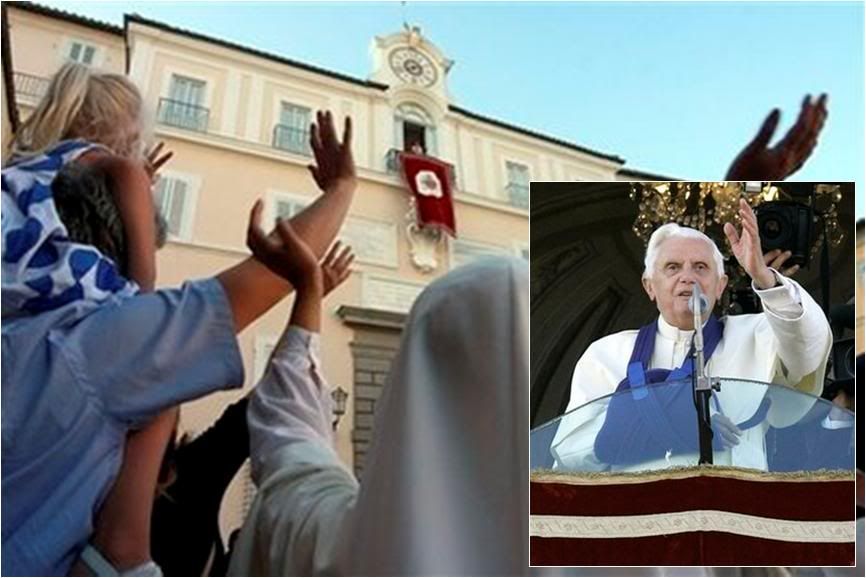
The Holy Father blesses the faithful as he 'checked into' the summer residence at Castel Gandolfo this evening. He will be here till early October - except for a pastoral visit to Viterbo and Bagnoregio, both near Rome, on September 6, and his apostolic visit to the Czech Republic on Sept. 26-28.
He made these brief remarks before imparting his blessing:
I have just come back from the mountains. Notwthstanding my little accident, they were very beautiful days, and now, I am happy to be in Castel Gandolfo with you, in this small and beautiful city, where I hope to be with you for some weeks.
I wish everyone beautiful weather, a good rest and a good vacation as much as possible.
It would be nice if an orthopedic supply company fashioned a couple of white arm slings for the Pope. I thought the standard blue sling would be immediately replaced by a papal-white one. But sapparently, no one has thought of it so far.
[Modificato da TERESA BENEDETTA 30/07/2009 04:02] |
| |
 30/07/2009 01:27 30/07/2009 01:27 |
|
| | | OFFLINE | | Post: 18.048
Post: 708 | Registrato il: 28/08/2005
Registrato il: 20/01/2009 | Administratore | Utente Senior | |
|
 I'm a few days late coming across this one, but it seems George Weigel has regained a more objective - and properly Christian - perspective on CIV. Minus all the bile of his first commentary, in which his ideological distaste for supposedly liberal members of the Pontifical Council for Justice and peace was so extreme as to spill over into what I hope was an unwitting insult to Benedict XVI, whom he accused, in effect, of incorporating PCJP positions he did not necessarily agree with!
I'm a few days late coming across this one, but it seems George Weigel has regained a more objective - and properly Christian - perspective on CIV. Minus all the bile of his first commentary, in which his ideological distaste for supposedly liberal members of the Pontifical Council for Justice and peace was so extreme as to spill over into what I hope was an unwitting insult to Benedict XVI, whom he accused, in effect, of incorporating PCJP positions he did not necessarily agree with!
Weigel wrote this for his weekly column in the Denver Catholic Register.
Benedict XVI and the truth about charity
by George Weigel

Issue of July 25, 2009, via

Pope Benedict XVI’s social encyclical, Caritas in Veritate [Charity in Truth], is a complex and occasionally obscure document, replete with possible implications for the future development of Catholic social doctrine. Sorting those implications out will take much time and even more careful reflection.
Along the information superhighway, however, careful reflection hit a few potholes in the early going, as sundry partisans sought to capture Caritas in Veritate as a weapon with which to bolster the Obama administration’s economic, health care, and social welfare policies.
Thus in the days immediately following the encyclical’s July 7 release, we were treated to the amusing, if somewhat ironic, spectacle of self-consciously progressive Catholic magazines, bloggers, and free-lancers, many of whom would have preferred to eat ground glass rather than see Joseph Ratzinger as Bishop of Rome, blasting those who dared raise questions about the encyclical’s intellectual provenance and some of its formulations.
Where were these stout-hearted crusaders when the going was tough – when, for example, the Pope was under fire for his Regensburg Lecture on Islam, or for attempting to reconcile four excommunicate Lefebvrist bishops to the Church?
But that was before we entered the new Messianic Age.
In any event, there is an important theme in Caritas in Veritate that, were all Catholics to take it seriously, might have a measurable impact on the American culture wars and on the U.S. Church’s internal struggle to define Catholic identity – and that is the encyclical’s insistence, repeated several times, that the life issues are social justice issues, so that Catholic social doctrine includes the Church’s defense of life from conception until natural death.
This teaching began with John Paul II’s 1995 encyclical, Evangelium Vitae [The Gospel of Life], in which John Paul warned that democracies risk becoming “tyrant states” if moral wrongs are legally declared “rights.” [I thought Paul VI's Populorum Progressio also raised the same issue earlier, especially since Paul VI considered PP a companion piece to his epochal and courageous encyclical Humanae Vitae!]
Then-Cardinal Joseph Ratzinger went a step further in his homily at the Mass for the Election of a Pope, on April 18, 2005. There, Ratzinger warned against a “dictatorship of relativism” in which coercive state power would be used to enforce the by-products of a culture skeptical about the human capacity to know the moral truth of anything: by-products such as abortion-on-demand, euthanasia, and “gay marriage.”
Now, as Benedict XVI, Ratzinger has moved the discussion further still, teaching that the defense of life is crucial to building the “human ecology” necessary to sustain just economic practices and protect the natural environment.
Caritas in Veritate has now put Catholic legislators and politicians on notice: you can’t duck the life issues, or vote the wrong way on the life issues, by hiding behind an alleged commitment to the Church’s social justice agenda.
Catholic social doctrine and the Church’s commitment to the right to life flow from the same source: the Catholic conviction about the inalienable dignity of every human life.
A robust culture of life, the Pope proposes, is essential for economic justice and environmental protection; it is also necessary if we are to avoid the dehumanization of a brave new world of stunted and manufactured humanity, the slippery slope to which is paved with misconceived compassion and embryo-destructive stem cell research.
Cari tas in Veritate thus reminds the whole Church that there is neither justice nor charity without truth. No society can claim to be promoting justice or solidarity if its law denies the truth of others’ humanity.
That is what Roe v. Wade and its judicial progeny have done in the United States; that is why laws protective of life from conception until natural death are an imperative of social justice; and that is why “common ground” efforts to lower the incidence of abortion, while welcome, are inadequate from the point of view of Catholic social doctrine — the moral equivalent of saying, in 1955, “OK, let’s see if we can’t get you black folks into one or two segregated restaurants in every county.”
Catholic legislators [and Obama Catholics] have been forcefully reminded of all this by the new Benedictine encyclical. The results in the U.S. Senate, the U.S. House of Representatives, and our state legislators should be instructive.
[Modificato da TERESA BENEDETTA 30/07/2009 01:34] |
| |
 30/07/2009 13:08 30/07/2009 13:08 |
|
| | | OFFLINE | | Post: 18.050
Post: 710 | Registrato il: 28/08/2005
Registrato il: 20/01/2009 | Administratore | Utente Senior | |
|

July 30
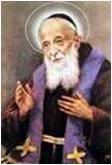 St. Peter Chrysologus (Italy, 380-450)
St. Peter Chrysologus (Italy, 380-450)
Bishop, Confessor, Doctor of the Church
'Doctor of Homilies'
OR today.
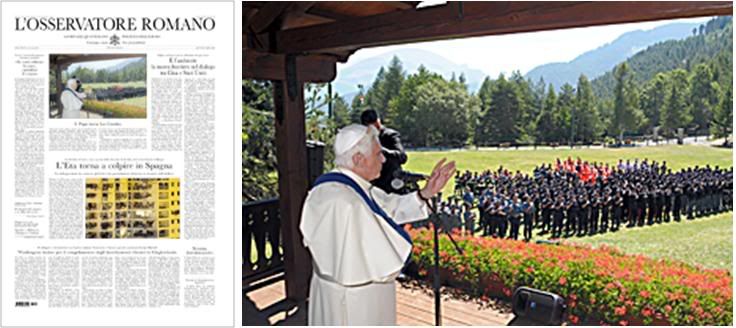 Page 1 stories today: The Pope leaves Les Combes; Vatican says Message for 2010 World Peace Day will be "If you wish
Page 1 stories today: The Pope leaves Les Combes; Vatican says Message for 2010 World Peace Day will be "If you wish
to cultivate peace, then safeguard Creation". nb secular news, ecology is the new frontier for US-China dialog; Basque terrorist
organization ETA strikes again in Spain, using a car bomb to attack a police building; and US special envoy to Israel insists
Netanyahu government must freeze Jewish settlements in the West Bank.
THE POPE'S DAY
No scheduled events today.
|
| |
 30/07/2009 16:41 30/07/2009 16:41 |
|
| | | OFFLINE | | Post: 18.053
Post: 713 | Registrato il: 28/08/2005
Registrato il: 20/01/2009 | Administratore | Utente Senior | |
|
 Pope cites Teilhardian vision
Pope cites Teilhardian vision
of the cosmos as a 'living host'

Jul. 28, 2009
John Allen is the first Anglophone commentator I have seen so far who picked up on Pope Benedict's citation of Teilhard de Chardin in his Vespers homily at Aosta Cathedral last week.
I posted the reading of that reference by two Italian Vaticanistas on this thread the day after the homily, with some background on Teilhard to place it in context. Allen reiterates much of the same background here.
Though few might have cast him in advance as a "green pope", Pope Benedict XVI has amassed a striking environmental record, from installing solar panels in the Vatican to calling for ecological conversion.
Now the Pontiff has also hinted at a possible new look at the undeclared patron saint of Catholic ecology, the late French Jesuit scientist and philosopher Pierre Teilhard de Chardin.
Benedict's brief July 24 reference to Teilhard, praising his vision of the entire cosmos as a "living host," can be read on multiple levels -- as part of the Pontiff's rapprochement with the Jesuits [Benedict would never make such a statement as a political move!, especially since it was so obviously extemperaneous, i.e, not premeditated or calculated], or as a further instance of finding something positive to say about thinkers whose works have set off doctrinal alarms, as Benedict previously did with rebel Swiss theologian and former colleague Hans Küng.
["Sonething positive to say about thinkers...like Hans Kueng'? That implies that Benedict had endorsed anything of Kueng's theology, when in fact, the Vatican statement issued after their September 2005 meeting (thought by most observres to have been written by the Pope himself) said the Pope expressed 'special support for Küng's efforts to build a Weltethos, or a moral framework based on values shared among religions which can also be recognized by secular reason", i.e., nothing theological.]
The potential implications for environmental theology, however, are likely to generate the greatest interest among Teilhard's fans and foes alike -- and more than a half-century after his death in 1955, the daring Jesuit still has plenty of both.
Admirers trumpet Teilhard as a pioneer, harmonizing Christianity with the theory of evolution; critics charge that Teilhard's optimistic view of nature flirts with pantheism.
Benedict's comment came during a July 24 vespers service in the Cathedral of Aosta in northern Italy, where the pope took his annual summer vacation July 13-29.
Toward the end of a reflection upon the Letter to the Romans, in which St. Paul writes that the world itself will one day become a form of living worship, the pope said, "It's the great vision that later Teilhard de Chardin also had: At the end we will have a true cosmic liturgy, where the cosmos becomes a living host.
[The homily was not a reflection on 'Romans'. The reference to Teilhard was made by the Pope, citing St. Paul afterwards, in the context of the siginificacne of liturgy in the mission of priests.]
"Let's pray to the Lord that he help us be priests in this sense," the Pope said, "to help in the transformation of the world in adoration of God, beginning with ourselves."
Though offered only in passing, and doubtless subject to overinterpretation, Benedict's line nevertheless triggered headlines in the Italian press about a possible "rehabilitation" of Teilhard, sometimes referred to as the "Catholic Darwin."
That reading seemed especially tempting since, as a consummate theologian, Benedict is aware of the controversy that swirls around Teilhard, and would thus grasp the likely impact of a positive papal reference.
At the very least, the line seemed to offer a blessing for exploration of the late Jesuit's ideas. That impression appeared to be confirmed by the Vatican spokesperson, Jesuit Fr. Federico Lombardi, who said afterward, "By now, no one would dream of saying that [Teilhard] is a heterodox author who shouldn't be studied."
Teilhard's most prominent living disciple in Italy, lay theologian Vito Mancuso, told reporters that he was "pleasantly surprised" by Benedict's words and that they have "great importance."
Teilhard, who died in 1955 at the age of 73, was a French Jesuit who studied paleontology and participated in the 1920s-era discovery of "Peking Man" in China, a find that seemed to confirm a gradual development in the human species. Teilhard has also been linked to the 1912 discovery of "Piltdown Man" in England, later exposed as a hoax.
On the basis of his scientific work, Teilhard developed an evolutionary theology asserting that all creation is developing towards an "Omega Point," which he identified with Christ as the Logos, or "Word" of God.
In that sense, Teilhard broadened the concept of salvation history to embrace not only individual persons and human culture, but the entire universe. In short order, Teilhard's thought became the obligatory point of departure for any Catholic treatment of the environment.
Yet from the beginning, Teilhard's theology was also viewed with caution by officials both of the Jesuit order and in the Vatican. Among other things, officials worried that his optimistic reading of nature compromised church teaching on original sin.
In 1962 -- seven years after his death -- the Vatican's doctrinal office issued a warning that his works "abound in such ambiguities and indeed even serious errors, as to offend Catholic doctrine."
In 1981, on the 100th anniversary of Teilhard's birth, speculation erupted about a possible rehabilitation. It was fueled by a letter published in L'Osservatore Romano, the Vatican newspaper, by the then-Cardinal Secretary of State Agostino Casaroli, who praised the "astonishing resonance of his research, as well as the brilliance of his personality and richness of his thinking."
Casaroli asserted that Teilhard had anticipated John Paul II's call to "be not afraid," embracing "culture, civilization and progress."
Responding to ferment created by the letter, the Vatican issued a statement insisting that its 1962 verdict on Teilhard still stands -- to date, Rome's last official pronouncement on Teilhard. (The statement was issued in July 1981, four months before then-Cardinal Joseph Ratzinger, the future Pope Benedict XVI, took over as prefect of the Congregation for the Doctrine of the Faith.)
Across the years, Benedict has sometimes seemed to be of two minds himself.
In his 1968 work Introduction to Christianity, Ratzinger wrote that Eastern Christianity has a deeper appreciation for the "cosmic and metaphysical" dimension of Christianity than the West, but that the West seemed to be recovering that perspective, "especially as a result of stimuli from the work of Teilhard." He argued that Teilhard gave authentic expression to the Christology of St. Paul.
As pope, Benedict has occasionally used language that seems to reflect a Teilhardian touch. In his 2006 Easter homily, the pontiff referred to the theory of evolution, describing the Resurrection as "the greatest 'mutation,' absolutely the most crucial leap into a totally new dimension that there has ever been in the long history of life and its development."
Yet Ratzinger's ambivalence about Teilhard is of equally long vintage. In a commentary on the final session of the Second Vatican Council (1962-65), a young Ratzinger complained that Gaudium et Spes, the "Pastoral Constitution on the Church in the Modern World," played down the reality of sin because of an overly "French," and specifically "Teilhardian," influence.
Overall, the impression is that Benedict finds much to like about Teilhard's cosmic vision, even if he also worries about interpretations at odds with orthodox faith. [This is a more correct statement than saying he has 'two minds' about Teilhard.]
Benedict's July 24 remark on Teilhard builds upon the Pope's strong record on the environment, considered by many observers to be the most original feature of his social teaching. [A rather superficial, limited and extremely selective consideration of CIV.]
Most recently, Benedict devoted a section of his new social encyclical, Caritas in Veritate, to a call for deepening what he called "that covenant between human beings and the environment, which should mirror the creative love of God."
In her recent book Ten Commandments for the Environment: Pope Benedict XVI Speaks Out for Creation and Justice, Catholic writer Woodeene Koenig-Bricker described Benedict as "the greenest Pope in history," arguing that he has not only made strong environmental statements but also put them into practice.
In that light, one wonders if Benedict's shade of green could eventually allow Teilhard to be named the patron saint of Catholic ecology de jure, as well as de facto. If so, July 24 could be remembered as the first stirring of an "evolutionary leap" in the late Jesuit's reputation and official standing.
 Personally, I find the use of a label like 'green Pope' rather tacky and objectionable. It calls to mind the image of Kermit the Frog wearing a miter. And it's a facile surrender to cliches which fossilize thought.
Personally, I find the use of a label like 'green Pope' rather tacky and objectionable. It calls to mind the image of Kermit the Frog wearing a miter. And it's a facile surrender to cliches which fossilize thought.
Primarily, it tends to conflate Benedict XVI in the popular mind with irresponsible and ideologically driven fanatics of global warming like Al Gore, when the Pope's concerns about the envirnoment are obviously so much more 'global and cosmic' than merely climate change!
This is underscored by the Vatican announcement yesterday of the theme he has chosen for his 2010 Message for the World Day of Peace - "To construct peace, look after Creation" [what God has created].
And Benedict's constant consciousness of the Creation we all are and live in, is not only because he lives in an age of ecological consciousness - if one might call it that, since although it is always written about, I don't know that the integral ecological message has really sunk into the minds of peoples and governments. Beyond, that is, the fashionably ideological monomania about global warming to the exclusion of other more scientifically established and far more worrying evidence of environmental degradation.
Above all, it is because Joseph Ratzinger/Benedict XVI has so obviously kept up with what's going on in science and technology, even on the technical level, to the point that he has not hesitated to apply modern scientific terminology to express some of his theological ideas. [And I do not doubt that he would be perfectly capable of carrying on a general discussion on, say, string theory with a contemporary physicist, or on pluripotent stem cells with a geneticist.]
That is unprecedented for a Pope. But then again, he is arguably the first Renaissance man that the Church has had for a Pope in centuries. Something his detractors cannot appreciate because they refuse to see it.
I also think that glibly labelling Teilhard de Chardin as 'patron saint for Catholic ecology' is a stretch - actually, a diminution - that almost trivializes his considerable intellectual work.
[Modificato da TERESA BENEDETTA 30/07/2009 20:28] |
| |
 30/07/2009 17:42 30/07/2009 17:42 |
|
| | | OFFLINE | | Post: 18.054
Post: 714 | Registrato il: 28/08/2005
Registrato il: 20/01/2009 | Administratore | Utente Senior | |
|


 And he practices what he preaches:
And he practices what he preaches:
Pope's Pentling residence
to generate solar power
for communal use
Translated from
the 7/30/09 issue of

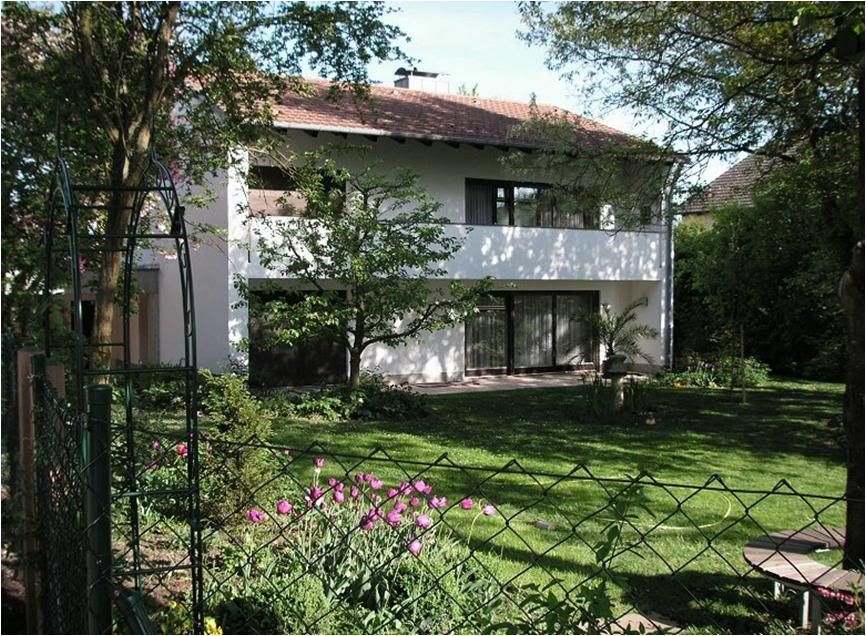

Joseph Ratzinger's house in the Regensburg suburb of Pentling will soon be a solar energy source to help provide energy requirements for a communal energy pool, according to the dpa German news agency. {I have not yet tried to look for the original report.]
For this purpose, the house, which was built for the future Pope in 1970 when he was a faculty member at the Unviersity of Regensburg, will be fitted with some 54 square meters of solar energy panels which will be able to produce about 5,800 kilowatts a year
Any income share accruing to the Pope from the distribution of the solar energy would go to an association that supports educational training for disadvantaged youth.
The Pope last visited his house on September 13, 2006, during his apostolic visit to Bavaria. His parents and sister Maria are buried in a nearby cemetery.
Before he became Pope, Ratzinger, as Archbishop of Munich and then as Prefect of the CDF, came home to Pentling at least twice a year - during the August summer vacation, and for Christmas and New Year.
As a professor at Regensburg, he said Mass at the local church daily and preached on Sundays. He is officially registered as a resident of Pentling since November 6, 1969. He was made an honorary citizen in 1987 on the occasion of his 60th birthday.
[Modificato da TERESA BENEDETTA 31/07/2009 04:04] |
| |
 30/07/2009 18:33 30/07/2009 18:33 |
|
| | | OFFLINE | | Post: 18.055
Post: 715 | Registrato il: 28/08/2005
Registrato il: 20/01/2009 | Administratore | Utente Senior | |
|

The Vatican has released the official program for the Holy Father's pastoral visit to Viterbo and Bagnoregio on Sunday, Sept. 6.
PASTORAL VISIT OF THE HOLY FATHER BENEDICT XVI
TO VITERBO AND BAGNOREGIO
Sunday, September 6, 2009
08.30 Departure by helicopter from the heliport of the Pontifical Villas in Castel Gandolfo
09.00 Arrival at the Rocchi communal sports field in Viterbo.
09.30 WELCOME CEREMONY at the stairway of the Palazzo dei Papi at the Piazza San Lorenzo
and a brief visit to the Conclave Hall 9where five Popes were elected).
10.15 EUCHARISTIC CONCELEBRATION at Valle Faul of Viterbo
- Homily by the Holy Father
- Recital of the Angelus
- Words by the Holy Father
Private lunch.
16.00 Travel to the Shrine of the Madonna della Quercia.
- Brief stop en route before the Shrine of St. Rosa of Viterbo
16.30 Private visit to the Shrine of the Madonna della Quercia
17.00 Departure by helicopter form the Rocchi sports field for Bagnoregio.
17.20 Arrival at the Alessandro Pompei sport field in Bagnoregio.
17.30 Visit to the Cathedral of St. Nicholas in Bagnoregio and
veneration of the relics of St. Bonaventure.
17.45 MEETING WITH THE FAITHFUL in Piazza Sant’Agostino
- Address by the Holy Father
18.30 Departure by helicopter from Bagnoregio for Castel Gandolfo.
19.30 Arrival in Castel Gandolfo.
 Further details of the visit were given by the Bishop of Viterbo in a Vatican Radio report posted on this thread two weeks ago:
benedettoxviforum.freeforumzone.leonardo.it/discussione.aspx?idd=8527...
A CNS report today gives some background about Viterbo as a medieval city tied closely to the history of the papacy:
Pope will visit Viterbo
Further details of the visit were given by the Bishop of Viterbo in a Vatican Radio report posted on this thread two weeks ago:
benedettoxviforum.freeforumzone.leonardo.it/discussione.aspx?idd=8527...
A CNS report today gives some background about Viterbo as a medieval city tied closely to the history of the papacy:
Pope will visit Viterbo
where papal conclaves were born
By Cindy Wooden

VATICAN CITY, July 30 (CNS) -- Pope Benedict XVI will interrupt his stay at the papal summer villa to make a one-day trip to the Italian city where the papal conclave was born.
In fact, he will visit the conclave room in the Palace of the Popes in Viterbo Sept. 6 before celebrating an outdoor Mass. The town is about 65 miles north of Rome.
Between 1261 and 1281, five of the eight popes who reigned were elected in Viterbo: Pope Urban IV, elected in 1261; Pope Gregory X in 1271; Pope John XXI in 1276; Pope Nicolas III in 1277; and Pope Martin IV in 1281.
Until 1271, the gathering of cardinals for the election was not called a conclave -- the word means under lock and key.
After Pope Clement IV died in 1268, the cardinals meeting in Viterbo could not elect his successor. The election dragged on, ultimately lasting 33 months.
It was not until city officials locked all of the cardinals in the meeting room, reduced their diet to bread and water and took the roof off the meeting hall that the cardinals elected Pope Gregory.
It was Pope Gregory who made it church law that papal elections would take place in a conclave.
Pope Benedict will travel to Viterbo by helicopter from the papal summer villa at Castel Gandolfo, south of Rome.
Before returning to Castel Gandolfo, the Pope will transfer by helicopter from Viterbo to Bagnoregio, where St. Bonaventure was born in 1217.
Pope Benedict wrote his postdoctoral thesis on the doctrine of revelation in the works of St. Bonaventure, a doctor of the church. The pope is scheduled to venerate the "holy arm" of the saint, which is kept in Bagnoregio's cathedral. The rest of the saint's body is buried in France.
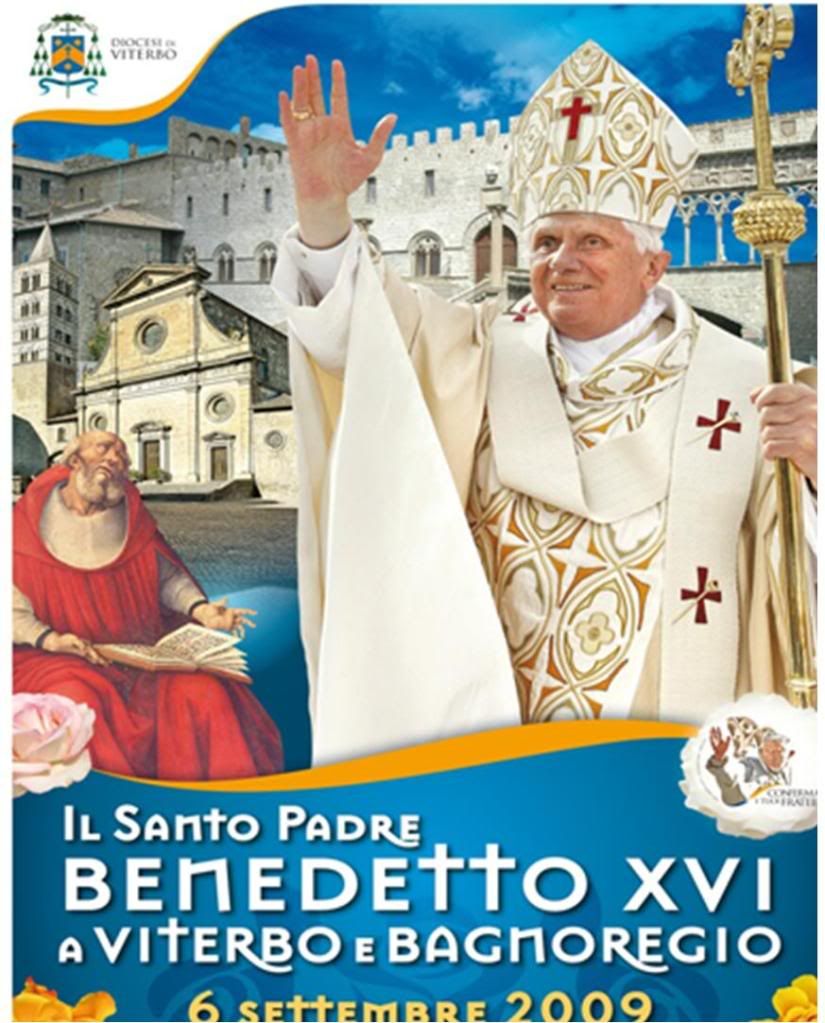
The site of the Diocese of Viterbo
dedicated to the Pope's visit:
www.ilpapaaviterbo.it/
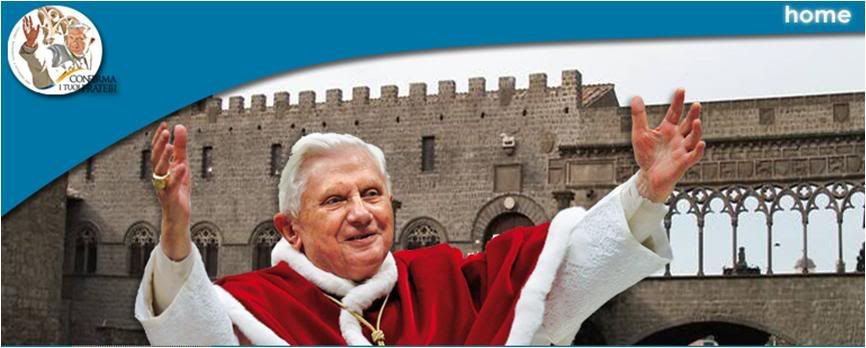 NB: The common element in the logo, the poster and the banner of the papal visit site is the distinctive loggia of the Palazzi dei Papi in Viterbo. The poster has the additional elements of the Cathedral of St. Nicholas and St. Bonaventure..
NB: The common element in the logo, the poster and the banner of the papal visit site is the distinctive loggia of the Palazzi dei Papi in Viterbo. The poster has the additional elements of the Cathedral of St. Nicholas and St. Bonaventure..
[Modificato da TERESA BENEDETTA 31/07/2009 02:12] |
| |
 31/07/2009 03:49 31/07/2009 03:49 |
|
| | | OFFLINE | | Post: 18.059
Post: 719 | Registrato il: 28/08/2005
Registrato il: 20/01/2009 | Administratore | Utente Senior | |
|
 It's odd to find this on Page 1 of tomorrow's issue (7/31/09) of L'Osservatore Romano, but their early afternoon deadline makes them one issue late in reporting anything that happens after 3 p.m.
THE POPE IN CASTEL GANDOLFO:
It's odd to find this on Page 1 of tomorrow's issue (7/31/09) of L'Osservatore Romano, but their early afternoon deadline makes them one issue late in reporting anything that happens after 3 p.m.
THE POPE IN CASTEL GANDOLFO:
He arrives after two weeks
in Val D'Aosta

July 31, 2009
There is a nice picture on page 1 - the Pope looks very lively despite having had a long day:
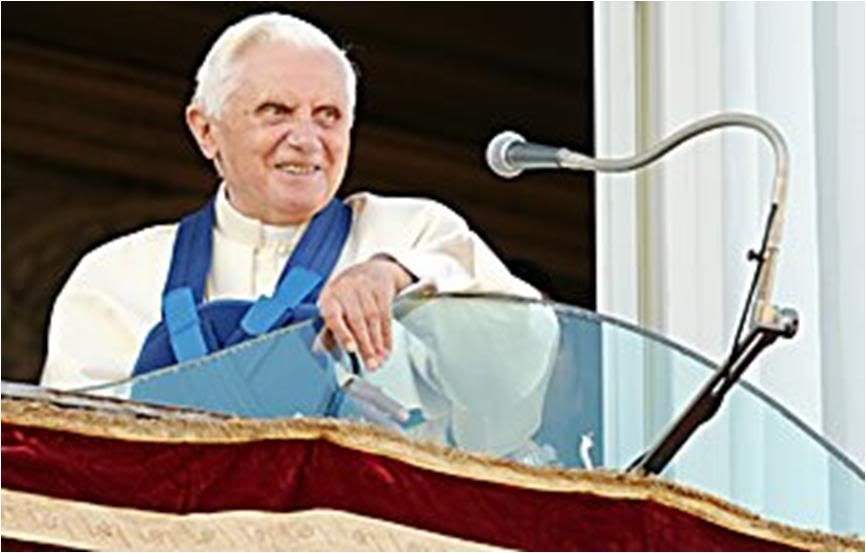
But the story is about the Pope's brief greeting to the people of Castel Gandolfo which we posted yesterday.
And in the inside pages, there is another story about his departure from Les Combes, also pretty well reported yesterday, with another nice photo:
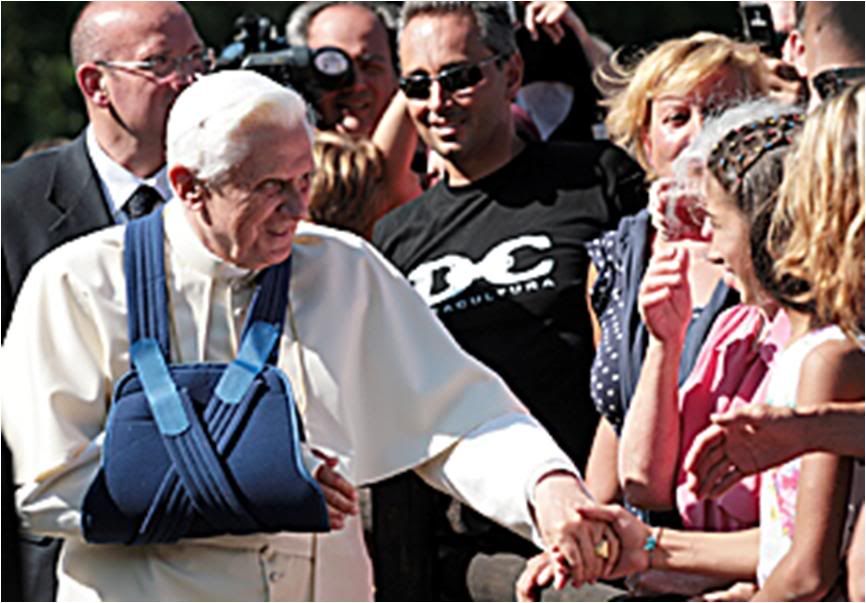
The account includes the farewell from the kids who gave him an edelweiss and an album of their drawings but no photo of that.
It mentions the Pope's helicopter flight from les Combes to Torino-Caselle airport, where he was met by the Archbishop of Turin, Cardinal Severino Poletto, and the Mayor of Turin, and then took an Italian military sirplane to Rome-Ciampino.
La Stampa in Turin had some good pictures of that brief Torino-Caselle stopover.
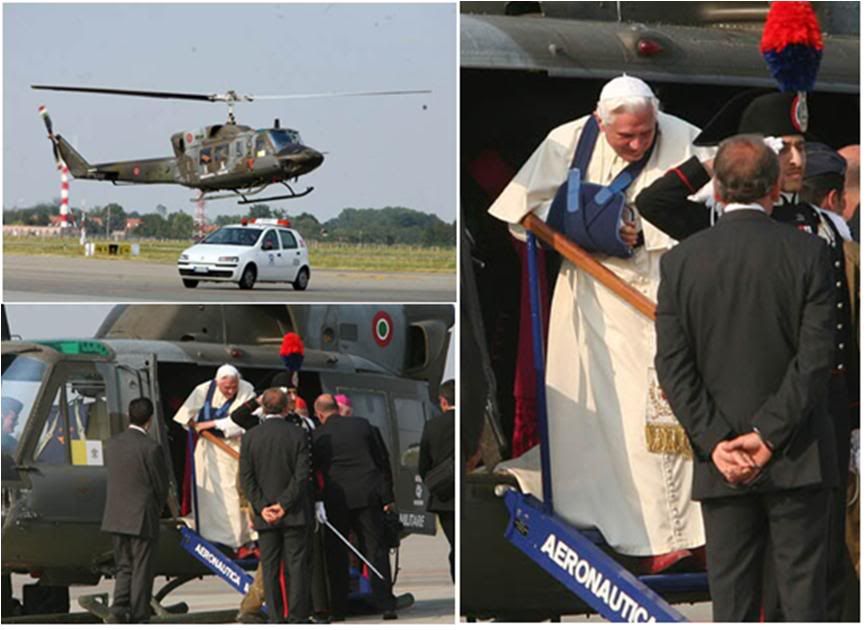
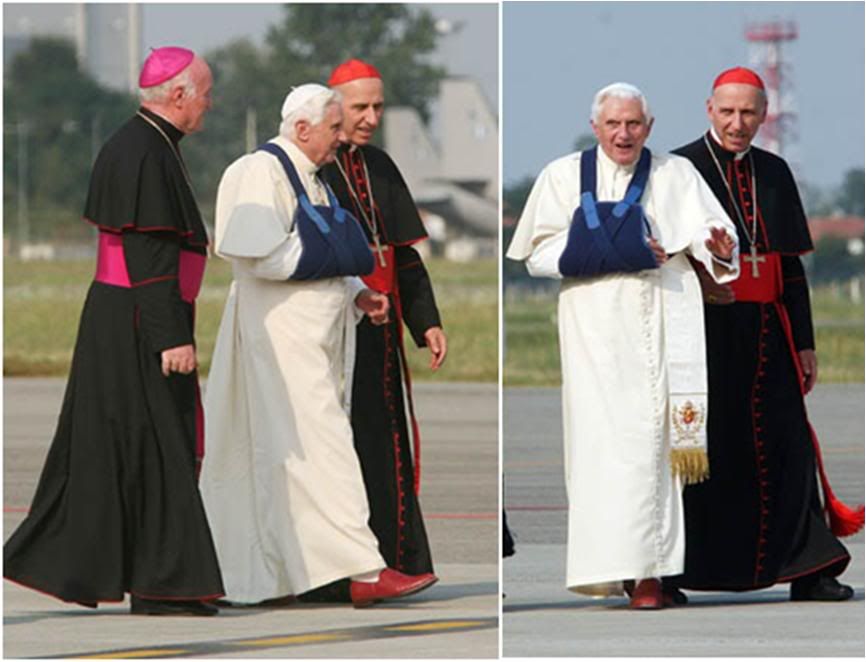

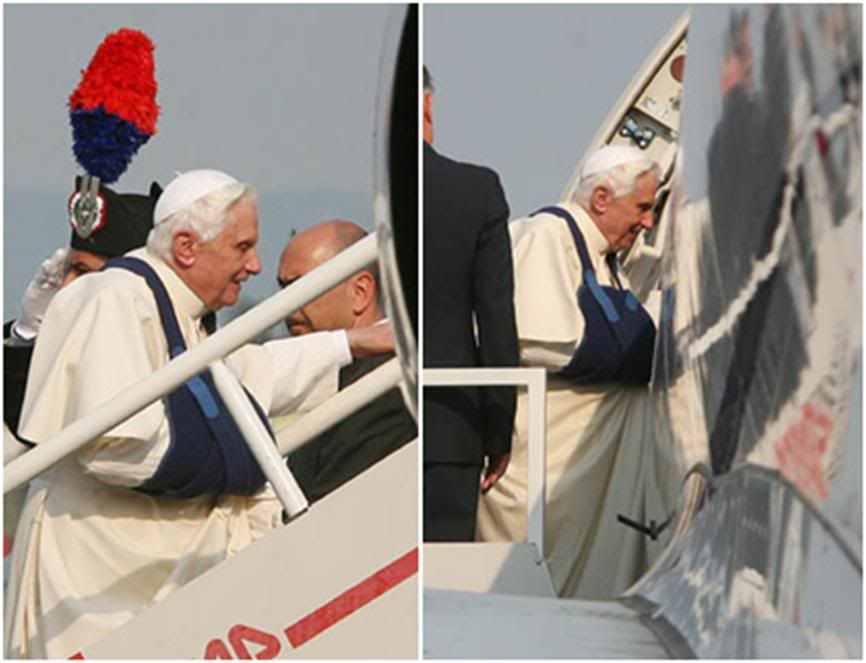

And a stray photo from the Angelus at Les Combes - when some local people give the Pope the gift of an Alpenstock, looks like, great for use on mountain walks:
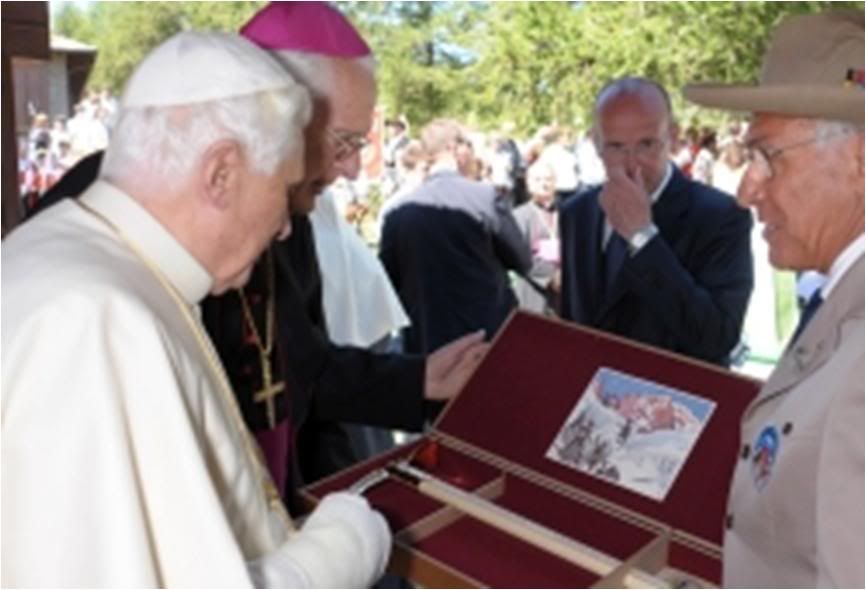
 There is some bread-and-butter news today
There is some bread-and-butter news today:
Pope invites priests of the world
to come to Rome for Year of Priests
closing conference next year

VATICAN CITY, JULY 30, 2009 (Zenit.org).- Benedict XVI is inviting priests from around the world to Rome next June to close the Year for Priests.
The International Conference for Priests will be held June 9-11, 2010, culminating with a Mass presided over by the Pope.
The theme for the conference, like that of the priestly year, is "Faithfulness of Christ, Faithfulness of Priests." The program includes moments of prayer, reflection, the chance to go to confession, and the papal Mass.
The organization of the event has been entrusted to Opera Romana Pellegrinaggi, the Vatican institution whose mission is to evangelize through pastoral tourism and the ministry of pilgrimage.
More information on the program and registration (for now, only in Italian) can be found at their Web site.
www.orpnet.org/
[Modificato da TERESA BENEDETTA 31/07/2009 15:51] |
| |
|
|
|
|